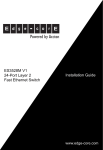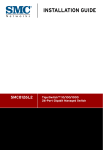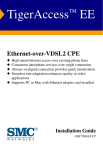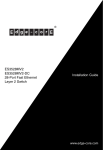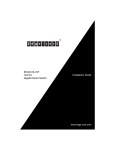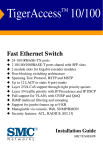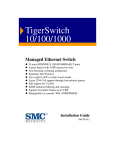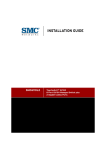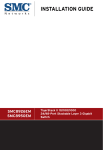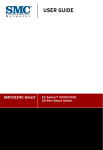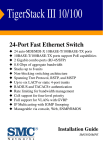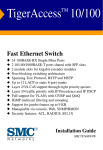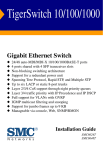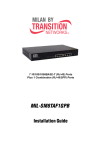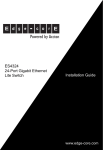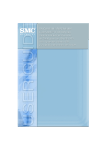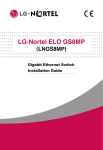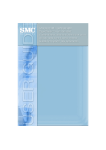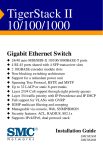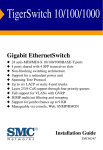Download SMC Networks VDSL2 User's Manual
Transcript
TigerAccess™ EE 6-Band VDSL2 Switch ◆ ◆ ◆ ◆ ◆ ◆ ◆ ◆ ◆ ◆ ◆ ◆ ◆ 16 VDSL Downlink Ports (1 RJ-21 Connector) 2 Gigabit Ethernet Combination Ports (RJ-45/SFP) 1 Fast Ethernet Management Port (RJ-45) Non-blocking switching architecture Spanning Tree Protocol, RSTP, and MSTP Up to 12 LACP or static 8-port trunks Layer 2/3/4 CoS support through eight priority queues Layer 3/4 traffic priority with IP Precedence and IP DSCP Full support for VLANs with GVRP IGMP multicast filtering and snooping Manageable via console, Web, SNMP/RMON Security features: ACL, RADIUS, 802.1x VDSL line configuration using Long-Reach Ethernet (LRE) commands, line profiles, and alarm profiles Installation Guide SMC7816M/VSW TigerAccess™ EE Installation Guide From SMC’s Tiger line of feature-rich workgroup LAN solutions 20 Mason Irvine, CA 92618 Phone: (949) 679-8000 February 2007 Pub. # 149100012100H Information furnished by SMC Networks, Inc. (SMC) is believed to be accurate and reliable. However, no responsibility is assumed by SMC for its use, nor for any infringements of patents or other rights of third parties which may result from its use. No license is granted by implication or otherwise under any patent or patent rights of SMC. SMC reserves the right to change specifications at any time without notice. Copyright © 2007 by SMC Networks, Inc. 20 Mason Irvine, CA 92618 All rights reserved. Printed in Taiwan Trademarks: SMC is a registered trademark; and EZ Switch, TigerAccess, TigerStack and TigerSwitch are trademarks of SMC Networks, Inc. Other product and company names are trademarks or registered trademarks of their respective holders. LIMITED WARRANTY Limited Warranty Statement: SMC Networks, Inc. (“SMC”) warrants its products to be free from defects in workmanship and materials, under normal use and service, for the applicable warranty term. All SMC products carry a standard 90-day limited warranty from the date of purchase from SMC or its Authorized Reseller. SMC may, at its own discretion, repair or replace any product not operating as warranted with a similar or functionally equivalent product, during the applicable warranty term. SMC will endeavor to repair or replace any product returned under warranty within 30 days of receipt of the product. The standard limited warranty can be upgraded to a Limited Lifetime* warranty by registering new products within 30 days of purchase from SMC or its Authorized Reseller. Registration can be accomplished via the enclosed product registration card or online via the SMC Web site. Failure to register will not affect the standard limited warranty. The Limited Lifetime warranty covers a product during the Life of that Product, which is defined as the period of time during which the product is an “Active” SMC product. A product is considered to be “Active” while it is listed on the current SMC price list. As new technologies emerge, older technologies become obsolete and SMC will, at its discretion, replace an older product in its product line with one that incorporates these newer technologies. At that point, the obsolete product is discontinued and is no longer an “Active” SMC product. A list of discontinued products with their respective dates of discontinuance can be found at: http://www.smc.com/index.cfm?action=customer_service_warranty. All products that are replaced become the property of SMC. Replacement products may be either new or reconditioned. Any replaced or repaired product carries either a 30-day limited warranty or the remainder of the initial warranty, whichever is longer. SMC is not responsible for any custom software or firmware, configuration information, or memory data of Customer contained in, stored on, or integrated with any products returned to SMC pursuant to any warranty. Products returned to SMC should have any customer-installed accessory or add-on components, such as expansion modules, removed prior to returning the product for replacement. SMC is not responsible for these items if they are returned with the product. Customers must contact SMC for a Return Material Authorization number prior to returning any product to SMC. Proof of purchase may be required. Any product returned to SMC without a valid Return Material Authorization (RMA) number clearly marked on the outside of the package will be returned to customer at customer’s expense. For warranty claims within North America, please call our toll-free customer support number at (800) 762-4968. Customers are responsible for all shipping charges from their facility to SMC. SMC is responsible for return shipping charges from SMC to customer. v WARRANTIES EXCLUSIVE: IF AN SMC PRODUCT DOES NOT OPERATE AS WARRANTED ABOVE, CUSTOMER’S SOLE REMEDY SHALL BE REPAIR OR REPLACEMENT OF THE PRODUCT IN QUESTION, AT SMC’S OPTION. THE FOREGOING WARRANTIES AND REMEDIES ARE EXCLUSIVE AND ARE IN LIEU OF ALL OTHER WARRANTIES OR CONDITIONS, EXPRESS OR IMPLIED, EITHER IN FACT OR BY OPERATION OF LAW, STATUTORY OR OTHERWISE, INCLUDING WARRANTIES OR CONDITIONS OF MERCHANTABILITY AND FITNESS FOR A PARTICULAR PURPOSE. SMC NEITHER ASSUMES NOR AUTHORIZES ANY OTHER PERSON TO ASSUME FOR IT ANY OTHER LIABILITY IN CONNECTION WITH THE SALE, INSTALLATION, MAINTENANCE OR USE OF ITS PRODUCTS. SMC SHALL NOT BE LIABLE UNDER THIS WARRANTY IF ITS TESTING AND EXAMINATION DISCLOSE THE ALLEGED DEFECT IN THE PRODUCT DOES NOT EXIST OR WAS CAUSED BY CUSTOMER’S OR ANY THIRD PERSON’S MISUSE, NEGLECT, IMPROPER INSTALLATION OR TESTING, UNAUTHORIZED ATTEMPTS TO REPAIR, OR ANY OTHER CAUSE BEYOND THE RANGE OF THE INTENDED USE, OR BY ACCIDENT, FIRE, LIGHTNING, OR OTHER HAZARD. LIMITATION OF LIABILITY: IN NO EVENT, WHETHER BASED IN CONTRACT OR TORT (INCLUDING NEGLIGENCE), SHALL SMC BE LIABLE FOR INCIDENTAL, CONSEQUENTIAL, INDIRECT, SPECIAL, OR PUNITIVE DAMAGES OF ANY KIND, OR FOR LOSS OF REVENUE, LOSS OF BUSINESS, OR OTHER FINANCIAL LOSS ARISING OUT OF OR IN CONNECTION WITH THE SALE, INSTALLATION, MAINTENANCE, USE, PERFORMANCE, FAILURE, OR INTERRUPTION OF ITS PRODUCTS, EVEN IF SMC OR ITS AUTHORIZED RESELLER HAS BEEN ADVISED OF THE POSSIBILITY OF SUCH DAMAGES. SOME STATES DO NOT ALLOW THE EXCLUSION OF IMPLIED WARRANTIES OR THE LIMITATION OF INCIDENTAL OR CONSEQUENTIAL DAMAGES FOR CONSUMER PRODUCTS, SO THE ABOVE LIMITATIONS AND EXCLUSIONS MAY NOT APPLY TO YOU. THIS WARRANTY GIVES YOU SPECIFIC LEGAL RIGHTS, WHICH MAY VARY FROM STATE TO STATE. NOTHING IN THIS WARRANTY SHALL BE TAKEN TO AFFECT YOUR STATUTORY RIGHTS. * SMC will provide warranty service for one year following discontinuance from the active SMC price list. Under the limited lifetime warranty, internal and external power supplies, fans, and cables are covered by a standard one-year warranty from date of purchase. SMC Networks, Inc. 20 Mason Irvine, CA 92618 vi COMPLIANCES FCC - Class A This equipment has been tested and found to comply with the limits for a Class A digital device, pursuant to part 15 of the FCC Rules. These limits are designed to provide reasonable protection against harmful interference when the equipment is operated in a commercial environment. This equipment generates, uses, and can radiate radio frequency energy and, if not installed and used in accordance with the instruction manual, may cause harmful interference to radio communications. Operation of this equipment in a residential area is likely to cause harmful interference in which case the user will be required to correct the interference at his own expense. You are cautioned that changes or modifications not expressly approved by the party responsible for compliance could void your authority to operate the equipment. You may use unshielded twisted-pair (UTP) for RJ-45 connections - Category 3 or better for 10 Mbps connections, Category 5 or better for 100 Mbps connections, Category 5, 5e, or 6 for 1000 Mbps connections. For fiber optic connections, you may use 50/125 or 62.5/125 micron multimode fiber or 9/125 micron single-mode fiber. FCC - Part 68 This equipment complies with Part 68 of FCC Rules. On the base unit of this equipment is a label that contains, among other information, the FCC Registration Number and Ringer Equivalence Number (REN) for this equipment. If requested, this information must be given to the telephone company. This equipment uses the following USOC jacks: RJ-21. The REN is useful to determine the quantity of devices you may connect to your telephone line and still have those entire devices ring when your telephone number is called. In most, but not all areas, the sum of the REN of all devices connected to one line should not exceed five (5.0). To be certain of the number of devices you may connect to you line, as determined by the REN, you should contact your local telephone company to determine the maximum REN for your calling area. If your equipment causes harm to the telephone network, the telephone company may discontinue your service temporarily. If possible, they will notify you in advance. But if advance notice is not practical, you will be notified as soon as possible. You will be informed of your right to file a complaint with the FCC. Your telephone company may make changes in its facilities, equipment, operations or procedures that could affect the proper functioning of your equipment. If they do, you will be notified in advance to give you an opportunity to maintain uninterrupted telephone service. If you experience trouble with this telephone equipment, please contact please contact our company at the numbers shown on back of this manual for information on obtaining service or repairs. The telephone company may ask that you disconnect this equipment from the vii COMPLIANCES network until the problem has been corrected or until you are sure that the equipment is not malfunctioning. This equipment may not be used on coin service provided by the telephone company. Connection to party lines is subject to state tariffs. Industry Canada - Class A This digital apparatus does not exceed the Class A limits for radio noise emissions from digital apparatus as set out in the interference-causing equipment standard entitled “Digital Apparatus,” ICES-003 of the Department of Communications. Cet appareil numérique respecte les limites de bruits radioélectriques applicables aux appareils numériques de Classe A prescrites dans la norme sur le matériel brouilleur: “Appareils Numériques,” NMB-003 édictée par le ministère des Communications. CE Mark Declaration of Conformance for EMI and Safety (EEC) SMC contact for these products in Europe is: SMC Networks Europe, Edificio Conata II, Calle Fructuós Gelabert 6-8, 2o, 4a, 08970 - Sant Joan Despí, Barcelona, Spain. This information technology equipment complies with the requirements of the Council Directive 89/336/EEC on the Approximation of the laws of the Member States relating to Electromagnetic Compatibility and 73/23/EEC for electrical equipment used within certain voltage limits and the Amendment Directive 93/68/EEC. For the evaluation of the compliance with these Directives, the following standards were applied: RFI Emission: • Limit class A according to EN 55022:1998 • Limit class A for harmonic current emission according to EN 61000-3-2/1995 • Limitation of voltage fluctuation and flicker in low-voltage supply system according to EN 61000-3-3/1995 Immunity: • Product family standard according to EN 55024:1998 • Electrostatic Discharge according to EN 61000-4-2:1995 (Contact Discharge: ±4 kV, Air Discharge: ±8 kV) • Radio-frequency electromagnetic field according to EN 61000-4-3:1996 (80 - 1000 MHz with 1 kHz AM 80% Modulation: 3 V/m) • Electrical fast transient/burst according to EN 61000-4-4:1995 (AC/ DC power supply: ±1 kV, Data/Signal lines: ±0.5 kV) viii COMPLIANCES • Surge immunity test according to EN 61000-4-5:1995 (AC/DC Line to Line: ±1 kV, AC/DC Line to Earth: ±2 kV) • Immunity to conducted disturbances, Induced by radio-frequency fields: EN 61000-4-6:1996 (0.15 - 80 MHz with 1 kHz AM 80% Modulation: 3 V/m) • Power frequency magnetic field immunity test according to EN 61000-4-8:1993 (1 A/m at frequency 50 Hz) • Voltage dips, short interruptions and voltage variations immunity test according to EN 61000-4-11:1994 (>95% Reduction @10 ms, 30% Reduction @500 ms, >95% Reduction @5000 ms) LVD: • EN 60950-1:2001 Warning: Do not plug a phone jack connector in the RJ-45 port. This may damage this device. Attention: Les raccordeurs ne sont pas utilisés pour le système téléphonique! Safety Compliance Warning: Fiber Optic Port Safety CLASS I LASER DEVICE When using a fiber optic port, never look at the transmit laser while it is powered on. Also, never look directly at the fiber TX port and fiber cable ends when they are powered on. Avertissment: Ports pour fibres optiques - sécurité sur le plan optique DISPOSITIF LASER DE CLASSE I Ne regardez jamais le laser tant qu’il est sous tension. Ne regardez jamais directement le port TX (Transmission) à fibres optiques et les embouts de câbles à fibres optiques tant qu’ils sont sous tension. Warnhinweis: Faseroptikanschlüsse - Optische Sicherheit LASERGERÄT DER KLASSE I Niemals ein Übertragungslaser betrachten, während dieses eingeschaltet ist. Niemals direkt auf den Faser-TX-Anschluß und auf die Faserkabelenden schauen, während diese eingeschaltet sind. PSE Alarm 本製品に同梱いたしております電源コードセットは、 本製品専用です。本電源コードセットは、本製品以外の 製品並びに他の用途でご使用いただくことは出来ません。 製品本体に同梱された電源コードセットを利用し、他製品 の電源コードセットを使用しないで下さい。 ix COMPLIANCES Power Cord Safety Please read the following safety information carefully before installing the switch: Warning: Installation and removal of the unit must be carried out by qualified personnel only. • The unit must be connected to an earthed (grounded) outlet to comply with international safety standards. • Do not connect the unit to an A.C. outlet (power supply) without an earth (ground) connection. • The appliance coupler (the connector to the unit and not the wall plug) must have a configuration for mating with an EN 60320/IEC 320 appliance inlet. • The socket outlet must be near to the unit and easily accessible. You can only remove power from the unit by disconnecting the power cord from the outlet. • This unit operates under SELV (Safety Extra Low Voltage) conditions according to IEC 60950. The conditions are only maintained if the equipment to which it is connected also operates under SELV conditions. France and Peru only This unit cannot be powered from IT† supplies. If your supplies are of IT type, this unit must be powered by 230 V (2P+T) via an isolation transformer ratio 1:1, with the secondary connection point labelled Neutral, connected directly to earth (ground). † Impédance à la terre Important! Before making connections, make sure you have the correct cord set. Check it (read the label on the cable) against the following: Power Cord Set U.S.A. and Canada The cord set must be UL-approved and CSA certified. The minimum specifications for the flexible cord are: - No. 18 AWG - not longer than 2 meters, or 16 AWG. - Type SV or SJ - 3-conductor The cord set must have a rated current capacity of at least 10 A The attachment plug must be an earth-grounding type with NEMA 5-15P (15 A, 125 V) or NEMA 6-15P (15 A, 250 V) configuration. Denmark The supply plug must comply with Section 107-2-D1, Standard DK2-1a or DK2-5a. Switzerland The supply plug must comply with SEV/ASE 1011. U.K. The supply plug must comply with BS1363 (3-pin 13 A) and be fitted with a 5 A fuse which complies with BS1362. The mains cord must be <HAR> or <BASEC> marked and be of type HO3VVF3GO.75 (minimum). x COMPLIANCES Power Cord Set (Continued) Europe The supply plug must comply with CEE7/7 (“SCHUKO”). The mains cord must be <HAR> or <BASEC> marked and be of type HO3VVF3GO.75 (minimum). IEC-320 receptacle. Veuillez lire à fond l'information de la sécurité suivante avant d'installer le Switch: AVERTISSEMENT: L’installation et la dépose de ce groupe doivent être confiés à un personnel qualifié. • Ne branchez pas votre appareil sur une prise secteur (alimentation électrique) lorsqu'il n'y a pas de connexion de mise à la terre (mise à la masse). • Vous devez raccorder ce groupe à une sortie mise à la terre (mise à la masse) afin de respecter les normes internationales de sécurité. • Le coupleur d’appareil (le connecteur du groupe et non pas la prise murale) doit respecter une configuration qui permet un branchement sur une entrée d’appareil EN 60320/IEC 320. • La prise secteur doit se trouver à proximité de l’appareil et son accès doit être facile. Vous ne pouvez mettre l’appareil hors circuit qu’en débranchant son cordon électrique au niveau de cette prise. • L’appareil fonctionne à une tension extrêmement basse de sécurité qui est conforme à la norme IEC 60950. Ces conditions ne sont maintenues que si l’équipement auquel il est raccordé fonctionne dans les mêmes conditions. xi COMPLIANCES France et Pérou uniquement: Ce groupe ne peut pas être alimenté par un dispositif à impédance à la terre. Si vos alimentations sont du type impédance à la terre, ce groupe doit être alimenté par une tension de 230 V (2 P+T) par le biais d’un transformateur d’isolement à rapport 1:1, avec un point secondaire de connexion portant l’appellation Neutre et avec raccordement direct à la terre (masse). Cordon électrique - Il doit être agréé dans le pays d’utilisation Etats-Unis et Canada: Le cordon doit avoir reçu l’homologation des UL et un certificat de la CSA. Les spécifications minimales pour un cable flexible sont AWG No. 18, ouAWG No. 16 pour un cable de longueur inférieure à 2 métres. - type SV ou SJ - 3 conducteurs Le cordon doit être en mesure d’acheminer un courant nominal d’au moins 10 A. La prise femelle de branchement doit être du type à mise à la terre (mise à la masse) et respecter la configuration NEMA 5-15P (15 A, 125 V) ou NEMA 6-15P (15 A, 250 V). Danemark: La prise mâle d’alimentation doit respecter la section 107-2 D1 de la norme DK2 1a ou DK2 5a. Suisse: La prise mâle d’alimentation doit respecter la norme SEV/ASE 1011. Europe La prise secteur doit être conforme aux normes CEE 7/7 (“SCHUKO”) LE cordon secteur doit porter la mention <HAR> ou <BASEC> et doit être de type HO3VVF3GO.75 (minimum). Bitte unbedingt vor dem Einbauen des Switches die folgenden Sicherheitsanweisungen durchlesen: WARNUNG: Die Installation und der Ausbau des Geräts darf nur durch Fachpersonal erfolgen. • Das Gerät sollte nicht an eine ungeerdete Wechselstromsteckdose angeschlossen werden. • Das Gerät muß an eine geerdete Steckdose angeschlossen werden, welche die internationalen Sicherheitsnormen erfüllt. • Der Gerätestecker (der Anschluß an das Gerät, nicht der Wandsteckdosenstecker) muß einen gemäß EN 60320/IEC 320 konfigurierten Geräteeingang haben. • Die Netzsteckdose muß in der Nähe des Geräts und leicht zugänglich sein. Die Stromversorgung des Geräts kann nur durch Herausziehen des Gerätenetzkabels aus der Netzsteckdose unterbrochen werden. • Der Betrieb dieses Geräts erfolgt unter den SELV-Bedingungen (Sicherheitskleinstspannung) gemäß IEC 60950. Diese Bedingungen sind nur gegeben, xii COMPLIANCES wenn auch die an das Gerät angeschlossenen Geräte unter SELV-Bedingungen betrieben werden. Stromkabel. Dies muss von dem Land, in dem es benutzt wird geprüft werden: Schweiz Dieser Stromstecker muß die SEV/ASE 1011Bestimmungen einhalten. Europe Das Netzkabel muß vom Typ HO3VVF3GO.75 (Mindestanforderung) sein und die Aufschrift <HAR> oder <BASEC> tragen. Der Netzstecker muß die Norm CEE 7/7 erfüllen (”SCHUKO”). Warnings and Cautionary Messages Warning: This product does not contain any serviceable user parts. Warning: Installation and removal of the unit must be carried out by qualified personnel only. Warning: When connecting this device to a power outlet, connect the field ground lead on the tri-pole power plug to a valid earth ground line to prevent electrical hazards. Warning: This switch uses lasers to transmit signals over fiber optic cable. The lasers are compliant with the requirements of a Class 1 Laser Product and are inherently eye safe in normal operation. However, you should never look directly at a transmit port when it is powered on. Caution: Wear an anti-static wrist strap or take other suitable measures to prevent electrostatic discharge when handling this equipment. Caution: Do not plug a phone jack connector in the RJ-45 port. This may damage this device. Les raccordeurs ne sont pas utilisé pour le système téléphonique! Caution: Use only twisted-pair cables with RJ-45 connectors that conform to FCC standards. Warnings (in German) Achtung: Dieses Produkt enthält keine Teile, die eine Wartung vom Benutzer benötigen. Achtung: Installation und Deinstallation des Gerätes müssen von qualifiziertem Servicepersonal durchgeführt werden. Achtung: Wenn das Gerät an eine Steckdose angeschlossen wird, muß der Masseanschluß am dreipoligen Netzstecker mit Schutzerde verbunden werden, um elektrische Gefahren zu vermeiden. Achtung: Dieses Gerät nutzt Laser zur Signalübertragung über Glasfasern. Die Laser entsprechen den Anforderungen an eine Lasereinrichtung der Klasse 1 und sind durch ihre Bauart im normalen Betrieb sicher für die Augen. Trotzdem sollte niemals direkt in den einen Übertragungskanal geblickt werden, wenn er eingeschaltet ist. xiii COMPLIANCES Environmental Statement The manufacturer of this product endeavours to sustain an environmentally-friendly policy throughout the entire production process. This is achieved though the following means: • • • • • • Adherence to national legislation and regulations on environmental production standards. Conservation of operational resources. Waste reduction and safe disposal of all harmful un-recyclable by-products. Recycling of all reusable waste content. Design of products to maximize recyclables at the end of the product’s life span. Continual monitoring of safety standards. End of Product Life Span This product is manufactured in such a way as to allow for the recovery and disposal of all included electrical components once the product has reached the end of its life. Manufacturing Materials There are no hazardous nor ozone-depleting materials in this product. Documentation All printed documentation for this product uses biodegradable paper that originates from sustained and managed forests. The inks used in the printing process are non-toxic. Purpose This guide details the hardware features of the switches, including Its physical and performance-related characteristics, and how to install each switch. Audience This guide is for system administrators with a working knowledge of network management. You should be familiar with switching and networking concepts. Zielgruppe Dieser Anleitung ist fuer Systemadministratoren mit Erfahrung im Netzwerkmangement. Sie sollten mit Switch- und Netzwerkkonzepten vertraut sein. Related Publications The following publication gives specific information on how to operate and use the management functions of the switches: The SMC7816M/VSW Management Guide Also, as part of both switches firmware, there is an online web-based help that describes all management related features. xiv TABLE OF CONTENTS 1 About the TigerAccess EE Switch . . . . . . . . . . . . . . . 1-1 Overview . . . . . . . . . . . . . . . . . . . . . . . . . . . . . . . . . . . . . . . . . . . . . . . . . 1-1 VDSL Technology . . . . . . . . . . . . . . . . . . . . . . . . . . . . . . . . . . . . 1-3 Switch Architecture . . . . . . . . . . . . . . . . . . . . . . . . . . . . . . . . . . . 1-4 Network Management Options . . . . . . . . . . . . . . . . . . . . . . . . . . 1-4 Description of Hardware . . . . . . . . . . . . . . . . . . . . . . . . . . . . . . . . . . . . . 1-5 RJ-21 Ports . . . . . . . . . . . . . . . . . . . . . . . . . . . . . . . . . . . . . . . . . . 1-6 1000BASE-T Ports . . . . . . . . . . . . . . . . . . . . . . . . . . . . . . . . . . . . 1-6 SFP Slots . . . . . . . . . . . . . . . . . . . . . . . . . . . . . . . . . . . . . . . . . . . . 1-7 Management Port . . . . . . . . . . . . . . . . . . . . . . . . . . . . . . . . . . . . . 1-7 Console Port . . . . . . . . . . . . . . . . . . . . . . . . . . . . . . . . . . . . . . . . . 1-8 Ethernet-over-VDSL CPE (Optional Equipment) . . . . . . . . . . . 1-8 Port and System Status LEDs . . . . . . . . . . . . . . . . . . . . . . . . . . . 1-8 Power Supply Socket . . . . . . . . . . . . . . . . . . . . . . . . . . . . . . . . . 1-10 Key Features . . . . . . . . . . . . . . . . . . . . . . . . . . . . . . . . . . . . . . . . . . . . . . 1-10 2 Network Planning . . . . . . . . . . . . . . . . . . . . . . . . . . . . 2-1 Introduction to Switching . . . . . . . . . . . . . . . . . . . . . . . . . . . . . . . . . . . . Application Examples . . . . . . . . . . . . . . . . . . . . . . . . . . . . . . . . . . . . . . . Internet Connections . . . . . . . . . . . . . . . . . . . . . . . . . . . . . . . . . . Remote Connections with Fiber Cable . . . . . . . . . . . . . . . . . . . . Making VLAN Connections . . . . . . . . . . . . . . . . . . . . . . . . . . . . Application Notes . . . . . . . . . . . . . . . . . . . . . . . . . . . . . . . . . . . . . . . . . . 3 2-1 2-1 2-2 2-3 2-3 2-5 Installing the Switch . . . . . . . . . . . . . . . . . . . . . . . . . . . 3-1 Preparing the Site for VDSL/POTS Connections . . . . . . . . . . . . . . . . . Installing Additional Equipment . . . . . . . . . . . . . . . . . . . . . . . . . Verifying Site Requirement . . . . . . . . . . . . . . . . . . . . . . . . . . . . . . . . . . . Installing Ethernet Cabling . . . . . . . . . . . . . . . . . . . . . . . . . . . . . . . . . . . Equipment Checklist . . . . . . . . . . . . . . . . . . . . . . . . . . . . . . . . . . . . . . . . Package Contents . . . . . . . . . . . . . . . . . . . . . . . . . . . . . . . . . . . . . Optional Rack-Mounting Equipment . . . . . . . . . . . . . . . . . . . . . Mounting . . . . . . . . . . . . . . . . . . . . . . . . . . . . . . . . . . . . . . . . . . . . . . . . . Rack Mounting . . . . . . . . . . . . . . . . . . . . . . . . . . . . . . . . . . . . . . . Desktop or Shelf Mounting . . . . . . . . . . . . . . . . . . . . . . . . . . . . . 3-1 3-2 3-2 3-3 3-4 3-4 3-5 3-5 3-5 3-7 xv TABLE OF CONTENTS Installing an Optional SFP Transceiver . . . . . . . . . . . . . . . . . . . . . . . . . 3-8 Connecting to a Power Source . . . . . . . . . . . . . . . . . . . . . . . . . . . . . . . . 3-9 Connecting to the Console Port . . . . . . . . . . . . . . . . . . . . . . . . . . . . . . 3-10 Wiring Map for Serial Cable . . . . . . . . . . . . . . . . . . . . . . . . . . . . 3-10 4 Making Network Connections . . . . . . . . . . . . . . . . . . . 4-1 Connecting RJ-21 Cables . . . . . . . . . . . . . . . . . . . . . . . . . . . . . . . . . . . . . 4-1 Connecting to the Punch-down Blocks . . . . . . . . . . . . . . . . . . . . 4-2 Using Patch Panels . . . . . . . . . . . . . . . . . . . . . . . . . . . . . . . . . . . . 4-3 Connecting Twisted-Pair Devices . . . . . . . . . . . . . . . . . . . . . . . . . . . . . . 4-4 Cabling Guidelines . . . . . . . . . . . . . . . . . . . . . . . . . . . . . . . . . . . . 4-4 Network Wiring Connections . . . . . . . . . . . . . . . . . . . . . . . . . . . 4-4 Connecting to PCs, Servers, Hubs and Switches . . . . . . . . . . . . 4-5 Connecting Fiber Optic Devices . . . . . . . . . . . . . . . . . . . . . . . . . . . . . . . 4-6 Connectivity Rules . . . . . . . . . . . . . . . . . . . . . . . . . . . . . . . . . . . . . . . . . . 4-7 1000BASE-T Cable Requirements . . . . . . . . . . . . . . . . . . . . . . . 4-8 1000 Mbps Gigabit Ethernet Cable Lengths . . . . . . . . . . . . . . . . 4-8 100 Mbps Fast Ethernet Cable Lengths . . . . . . . . . . . . . . . . . . . 4-9 10 Mbps Ethernet Cable Lengths . . . . . . . . . . . . . . . . . . . . . . . . 4-9 Cable Labeling and Connection Records . . . . . . . . . . . . . . . . . . . . . . . 4-10 xvi TABLE OF CONTENTS APPENDICES: A Troubleshooting . . . . . . . . . . . . . . . . . . . . . . . . . . . . . .A-1 Diagnosing Switch Indicators . . . . . . . . . . . . . . . . . . . . . . . . . . . . . . . . . A-1 Power and Cooling Problems . . . . . . . . . . . . . . . . . . . . . . . . . . . . . . . . . A-3 Installation . . . . . . . . . . . . . . . . . . . . . . . . . . . . . . . . . . . . . . . . . . . . . . . . A-3 In-Band Access . . . . . . . . . . . . . . . . . . . . . . . . . . . . . . . . . . . . . . . . . . . . A-3 B Cables . . . . . . . . . . . . . . . . . . . . . . . . . . . . . . . . . . . . . .B-1 Twisted-Pair Cable and Pin Assignments . . . . . . . . . . . . . . . . . . . . . . . . B-1 10BASE-T/100BASE-TX Pin Assignments . . . . . . . . . . . . . . . . B-2 Straight-Through Wiring . . . . . . . . . . . . . . . . . . . . . . . . . . . . . . . B-3 Crossover Wiring . . . . . . . . . . . . . . . . . . . . . . . . . . . . . . . . . . . . . B-4 1000BASE-T Pin Assignments . . . . . . . . . . . . . . . . . . . . . . . . . . B-5 1000BASE-T Cable Requirements . . . . . . . . . . . . . . . . . . . . . . . B-6 Cable Testing for Existing Category 5 Cable . . . . . . . . . . . . . . . B-6 Adjusting Existing Category 5 Cabling to Run 1000BASE-T . . B-6 Fiber Standards . . . . . . . . . . . . . . . . . . . . . . . . . . . . . . . . . . . . . . . . . . . . . B-7 RJ-21 Port Pin Assignments . . . . . . . . . . . . . . . . . . . . . . . . . . . . . . . . . . B-8 Console Port Pin Assignments . . . . . . . . . . . . . . . . . . . . . . . . . . . . . . . . B-9 DB-9 Port Pin Assignments . . . . . . . . . . . . . . . . . . . . . . . . . . . . . B-9 Console Port to 9-Pin DTE Port on PC . . . . . . . . . . . . . . . . . . B-10 Console to 25-Pin DTE Port on PC . . . . . . . . . . . . . . . . . . . . B-10 C Specifications . . . . . . . . . . . . . . . . . . . . . . . . . . . . . . . .C-1 Physical Characteristics . . . . . . . . . . . . . . . . . . . . . . . . . . . . . . . . . . . . . . C-1 Switch Features . . . . . . . . . . . . . . . . . . . . . . . . . . . . . . . . . . . . . . . . . . . . C-3 Management Features . . . . . . . . . . . . . . . . . . . . . . . . . . . . . . . . . . . . . . . C-3 Standards . . . . . . . . . . . . . . . . . . . . . . . . . . . . . . . . . . . . . . . . . . . . . . . . . C-4 Compliances . . . . . . . . . . . . . . . . . . . . . . . . . . . . . . . . . . . . . . . . . . . . . . . C-4 D Ordering Information . . . . . . . . . . . . . . . . . . . . . . . . . D-1 Glossary Index xvii TABLES Table 1-1 Table 1-2 Table 1-3 Table 3-1 Table 3-2 Table 4-1 Table 4-2 Table 4-4 Table 4-5 Table 4-6 Table 4-3 Table A-1 Table B-1 Table B-2 Table B-3 Table B-4 Table B-5 Table B-6 Table B-7 Table D-1 xviii Optional SFP Transceivers . . . . . . . . . . . . . . . . . . . . . . . . . . . . 1-7 Port Status LEDs . . . . . . . . . . . . . . . . . . . . . . . . . . . . . . . . . . . 1-9 System Status LEDs . . . . . . . . . . . . . . . . . . . . . . . . . . . . . . . . . 1-9 Optional SFP Transceivers . . . . . . . . . . . . . . . . . . . . . . . . . . . . 3-8 Wiring Map for Serial Cable . . . . . . . . . . . . . . . . . . . . . . . . . . 3-10 Maximum 1000BASE-T Gigabit Ethernet Cable Length . . . . 4-8 Maximum 1000BASE-SX Gigabit Ethernet Cable Length . . 4-8 Maximum 1000BASE-ZX Gigabit Ethernet Cable Length . . 4-9 Maximum Fast Ethernet Cable Length . . . . . . . . . . . . . . . . . . 4-9 Maximum Ethernet Cable Length . . . . . . . . . . . . . . . . . . . . . . 4-9 Maximum 1000BASE-LX Gigabit Ethernet Cable Length . . 4-9 Diagnosing Switch Indicators . . . . . . . . . . . . . . . . . . . . . . . . . A-1 10/100BASE-TX MDI and MDI-X Port Pinouts . . . . . . . . . B-2 1000BASE-T MDI and MDI-X Port Pinouts . . . . . . . . . . . . . B-5 RJ-21 Port Pin Assignments (PBX/MDF connector) . . . . . . B-8 RJ-21 Port Pin Assignments (VDSL Line connector) . . . . . . B-8 DB-9 Port Pin Assignments . . . . . . . . . . . . . . . . . . . . . . . . . . . B-9 Console Port to 9-Pin DTE Port on PC . . . . . . . . . . . . . . . . B-10 Console to 25-Pin DTE Port on PC . . . . . . . . . . . . . . . . . . . B-10 TigerAccess EE Products and Accessories . . . . . . . . . . . . . . .D-1 FIGURES Figure 1-1 Figure 1-2 Figure 1-3 Figure 1-4 Figure 2-1 Figure 2-2 Figure 2-3 Figure 3-1 Figure 3-2 Figure 3-3 Figure 3-4 Figure 3-5 Figure 3-6 Figure 3-7 Figure 3-8 Figure 3-9 Figure 4-1 Figure 4-2 Figure 4-3 Figure 4-4 Figure 4-5 Figure B-1 Figure B-2 Figure B-3 Figure B-4 Figure B-5 VDSL Application . . . . . . . . . . . . . . . . . . . . . . . . . . . . . . 1-3 Front and Rear Panels . . . . . . . . . . . . . . . . . . . . . . . . . . . . 1-6 Port and System LEDs . . . . . . . . . . . . . . . . . . . . . . . . . . . 1-8 Power Supply Socket . . . . . . . . . . . . . . . . . . . . . . . . . . . 1-10 Internet Connections . . . . . . . . . . . . . . . . . . . . . . . . . . . . 2-2 Remote Connections with Fiber Cable . . . . . . . . . . . . . . 2-3 Making VLAN Connections . . . . . . . . . . . . . . . . . . . . . . . 2-4 Wiring before VDSL Switch Installation . . . . . . . . . . . . . 3-1 Wiring after Switch Installation . . . . . . . . . . . . . . . . . . . . 3-2 RJ-45 Connections . . . . . . . . . . . . . . . . . . . . . . . . . . . . . . 3-4 Attaching the Brackets . . . . . . . . . . . . . . . . . . . . . . . . . . . 3-6 Installing the Switch in a Rack . . . . . . . . . . . . . . . . . . . . . 3-6 Attaching the Adhesive Feet . . . . . . . . . . . . . . . . . . . . . . 3-7 Inserting an SFP Transceiver into a Slot . . . . . . . . . . . . . 3-8 Power Socket . . . . . . . . . . . . . . . . . . . . . . . . . . . . . . . . . . . 3-9 Serial Port (RJ-45) Pin-Out . . . . . . . . . . . . . . . . . . . . . . . 3-10 Connecting to the Punch-down Blocks . . . . . . . . . . . . . . 4-2 Using Patch Panels . . . . . . . . . . . . . . . . . . . . . . . . . . . . . . 4-3 Network Wiring Connections . . . . . . . . . . . . . . . . . . . . . 4-4 Customer Premises Connections . . . . . . . . . . . . . . . . . . . 4-5 Making LC Port Connections . . . . . . . . . . . . . . . . . . . . . . 4-7 RJ-45 Connector Pin Numbers . . . . . . . . . . . . . . . . . . . . B-1 Straight-through Wiring . . . . . . . . . . . . . . . . . . . . . . . . . . B-3 Crossover Wiring . . . . . . . . . . . . . . . . . . . . . . . . . . . . . . . B-4 RJ-21 Port Pins . . . . . . . . . . . . . . . . . . . . . . . . . . . . . . . . . B-8 DB-9 Console Port Pin Numbers . . . . . . . . . . . . . . . . . . B-9 xix FIGURES xx CHAPTER 1 ABOUT THE TIGERACCESS EE SWITCH Overview This Ethernet-over-VDSL system consists of end-user CPEs (Customer Premise Equipment) connected to a VDSL switch by standard telephone cable. The VDSL connection delivers an Ethernet data link while simultaneously supporting standard telephone services. The system can be deployed in any multi-dwelling/multi-tenant environment (apartment blocks, hotels, or office complex) to provide both high-speed Internet access and telephone services without any need for re-wiring. The VDSL switch has a built-in POTS splitter that combines both the data and phone signals coming from your Internet and telephone service providers, and passes these signals directly over standard telephone wiring to multiple users in the same building. A CPE is then used to separate these signals and pass them on to a customer’s computer and telephone equipment. Using the pre-defined profiles, in-building connections can operate up to 100 Mbps upstream and downstream for runs up to 200 meters (656 ft). Note: Type-1 26 AWG (100 ohm)/0.4 mm, or Type-2 24 AWG (100 ohm)/0.5 mm cable may be installed to achieve the maximum distance. However, typically 24 AWG (100 ohm)/0.5 mm wire provides better performance than 26 AWG (100 ohm)/0.4 mm wire. Note the distance may be limited by factors such as how the cable is bundled, and the interference and noise on the link. 1-1 ABOUT THE TIGERACCESS EE SWITCH The VDSL switch is typically located in a wiring closet or other central location of a multi-dwelling/multi-tenant unit, campus or enterprise. An Internet connection is provided from the ISP to the customer’s building over fiber optic cable, running Ethernet directly over a 1 Gbps connection. (Trunking both uplink ports together can provide a 2 Gbps connection.) This kind of WAN connection is referred to as fiber To The Building (FTTB). The data and phone signals for each user are combined in the switch, and passed over VDSL lines to individual customers. The CPE at the other end of the VDSL line connects to any PC or Macintosh equipped with a 10/100BASE-TX network interface card. Your existing telephone, modem, or fax machine simply plugs into the CPE’s phone port. There is no need for special terminators or filters. In fact, there is no need to modify your wiring at all. Since the VDSL connection is based on Ethernet, no further complex software configurations are required. 1-2 OVERVIEW VDSL Technology VDSL2 (Very High Bit-Rate Digital Subscriber Line) is at the high-end of all the DSL technologies, offering the best combination of fiber optic and copper to provide high-speed broadband Internet access. VDSL’s primary application is in providing a broadband data service to multi-tenant residential or commercial buildings. In this implementation, fiber optic cable carries data from an Internet Service Provider to the building; then the installed telephone copper wires take the data and deliver it to individual units within that building. Telephone Rooms/Clients VDSL CPE Floor 2 Telephone/Fax Rooms/Clients Existing Phone Lines to Clients Punch Down Blocks / Patch Panels Floor 1 VDSL CPE Local Servers (Locally Hosted Services, Video Servers, Billing) VDSL Lines VDSL Switch MPOE TM C7 TigerAccess SM EE 81 Switch 6M /V SW E POTS 18 ESD O E 17 O Line 1 Console 2 3 4 100 - 240V 50 - 60Hz 5 6 7 8 9 10 11 13 14 15 Power E 17 O18 Fault Mgmt PORT Phone Lines Diag E Mgmt 12 16 O Telephone Line from Central Office 1A Central Office (PSTN) PBX Fiber Optic Link to ISP Multi-dwelling/Multi-tenant Building ISP (Internet) Figure 1-1 VDSL Application VDSL provides high-speed Internet access over existing phone lines by making use of previously unused frequency bandwidth above the voice band (i.e., up to 30 MHz with VDSL2). By placing VDSL signals above the frequency of the voice signal, a VDSL service can coexist on the same line as other telephone services. VDSL can operate symmetrically, providing the same data rate in both directions, or asymmetrically, providing a higher data rate in the downstream (receive) direction than in the upstream (transmit) direction. 1-3 ABOUT THE TIGERACCESS EE SWITCH VDSL can deliver high-performance online applications, such as high-quality video and other switched multimedia services. This Ethernet-over-VDSL system provides robust performance, with a maximum symmetric data rate of 100 Mbps for runs up to 200 meters (656 ft). This system is based on advanced VDSL2 Multi-Carrier Modulation (MCM) technology with adaptive channel equalization that overcomes bridge taps and other line distortions. Reed-Solomon Forward Error Correction and interleaving protect against errors due to impulse noise and enable recovery from signal interruptions. Frequency Division Duplexing (FDD) separates downstream and upstream channels and allows VDSL signals to coexist with regular telephone services. A power back-off mechanism is also implemented to reduce noise from crosstalk in line bundles. Switch Architecture The VDSL Switch employs a wire-speed, non-blocking switching fabric. This permits simultaneous wire-speed transport of multiple packets at low latency on all ports. This switch also features full-duplex capability on all ports, which effectively doubles the bandwidth of each connection. For communications between different VLANs, this switch uses IP routing. For communications within the same VLAN, the switch uses store-and-forward switching to ensure maximum data integrity. With store-and-forward switching, the entire packet must be received into a buffer and checked for validity before being forwarded. This prevents errors from being propagated throughout the network. Network Management Options This switch contains a comprehensive array of LEDs for “at-a-glance” monitoring of network and port status. It also includes a management agent that allows you to configure or monitor the switch using its embedded management software, or via SNMP applications. To manage the switch, you can make a direct connection to the console port (out-of-band), or you can manage the switch through a network 1-4 DESCRIPTION OF HARDWARE connection (in-band) using Telnet, the on-board web agent, or SNMP-based network management software. The management port provides a dedicated management channel that operates outside of the data transport network. This makes it possible to re-configure or troubleshoot the switch over either a local or remote connection when access via the data channel is not possible or deemed insecure. For a detailed description of the switch’s advanced features, refer to the Management Guide. Description of Hardware This device is an intelligent Layer 2 VDSL2 switch with 16 VDSL ports for subscriber access to the data network, and two Gigabit Ethernet combination ports* for uplink traffic. The uplink ports are implemented as 10/100/1000BASE-T ports shared with SFP transceiver slots (see Figure 1-1, Ports 17-18). The switch also includes one 10/100BASE-TX port for dedicated management access (which can be operated outside the data channel). The VDSL switch combines data and voice signals for delivery over standard telephone cable to multiple users in residential or commercial buildings. Ethernet data signals are received on the switch uplink port(s) and passed to the 16 VDSL ports on the front panel via 16 internal Ethernet ports. * If an SFP transceiver is plugged in, the corresponding RJ-45 port (17 or 18) is disabled. 1-5 ABOUT THE TIGERACCESS EE SWITCH The following figure shows the components of the VDSL switch. VDSL Line Connector (to end users) Ethernet Port Status Indicators Console Port PBX/MDF Connectors (to POTS provider ) Console 1 5 9 13 2 6 10 14 11 15 12 16 3 7 4 8 100 - 240V 50 - 60Hz 1A Power Socket E 17 O E 18 O Power Line Mgmt O 17 E O POTS 18 E TigerAccess TM EE Switch SMC7816M/ VSW Fault Diag Mgmt ESD PORT System Status VDSL Port Status Indicators Indicators 100BASE-TX Management Port 1000BASE-T RJ-45/SFP Uplink Ports Figure 1-2 Front and Rear Panels RJ-21 Ports The RJ-21 ports on the switch front panel support 16 twisted-pair connections. The “Line” port connects to end-user CPEs through a punch-down box. The “POTS” port connects to the local PBX or directly to telephone lines from the CO. 1000BASE-T Ports The switch contains two Gigabit RJ-45 ports shared with alternate Small Form Factor Pluggable (SFP) transceiver slots. The 1000BASE-T RJ-45 ports operate at 10/100 Mbps, half/full duplex, or at 1000 Mbps, full duplex. Because all of the RJ-45 ports support automatic MDI/MDI-X operation, you can use straight-through cables for all network connections to PCs or servers, or to other switches or hubs. (See “1000BASE-T Pin Assignments” on page B-3.) Each of these ports support auto-negotiation, so the optimum transmission mode (half or full duplex), and data rate (10, 100, or 1000 Mbps) can be selected automatically. If a device connected to one of these ports does not support auto-negotiation, the communication mode of that port can be configured manually. 1-6 DESCRIPTION OF HARDWARE Each port also supports auto-negotiation of flow control, so the switch can automatically prevent port buffers from becoming saturated. Note: If an SFP transceiver (purchased separately) is installed in a slot and has a valid link on the port, the associated RJ-45 port is disabled. SFP Slots The Small Form Factor Pluggable (SFP) transceiver slots are shared with RJ-45 ports (ports 17~18). In its default configuration, if an SFP transceiver (purchased separately) is installed in a slot and has a valid link on its port, the associated RJ-45 port is disabled and cannot be used. The switch can also be configured to force the use of an RJ-45 port or SFP slot, as required. Table 1-1 Optional SFP Transceivers 1000BASE-SX (SMCBGSLCX1) 1000BASE-LX (SMCBGLLCX1) 1000BASE-ZX (SMCBGZLCX1) Note that 1000BASE-SX transceivers use multimode duplex fiber cable, 1000BASE-LX and 1000BASE-ZX transceivers use single-mode duplex fiber cable. Management Port The 100BASE-TX port labeled “Mgmt” provides a dedicated management interface which is segregated from the data traffic crossing the other ports. This port supports auto-negotiation, so the optimum data rate and transmission mode (10/100 Mbps at half/full duplex) can be selected automatically, if this feature is also supported by the attached device. However, note that the interface connection parameters of this port cannot be configured. 1-7 ABOUT THE TIGERACCESS EE SWITCH Console Port The console port on the switch’s front panel is a DB-9 connector that enables a connection to a terminal for performing switch monitoring and configuration functions. The terminal may be a PC or workstation running terminal emulation software, or a terminal configured as a Data Terminal Equipment (DTE) connection. A null-modem wired serial cable is supplied with the switch for connecting to this interface. Ethernet-over-VDSL CPE (Optional Equipment) The VDSL switch is designed to connect to the RJ-11 VDSL Line port on a CPE. The CPE provides users with a high-speed Internet connection via the RJ-45 Ethernet port and a standard telephone connection via the RJ-11 phone jack. Port and System Status LEDs The switch includes key system and port indicators that simplify installation and network troubleshooting. The LEDs, which are located on the front panel for easy viewing, are shown below and described in the following table. 1 5 9 13 2 6 10 14 3 7 11 15 4 8 12 16 E 17 O E 18 O Power Fault Diag Mgmt Figure 1-3 Port and System LEDs 1-8 L DESCRIPTION OF HARDWARE Table 1-2 Port Status LEDs LED Condition Status VDSL Ports Link/Act (Port 1-16) On Green Port has a valid link Flashing Green Flashing indicates activity on the port Off The link is down, or port is disabled On Green Port has a valid link Flashing Green Flashing indicates activity on the port Off The link is down, or port is disabled On Green Port has a valid link Flashing Green Flashing indicates activity on the port Off The link is down, or port is disabled Uplink Ports Link/Act (Port 17-18) E: RJ-45 O: SFP Management Port Mgmt (Port 19) Table 1-3 System Status LEDs LED Power Condition Status On Green Switch is receiving power Off Switch is not receiving power Fault Amber A fan has failed, the temperature threshold exceeded, or other hardware malfunction Diag Flashing Green System diagnostic test in progress On Green System diagnostic test successfully completed Off System self-diagnostic test has detected a fault 1-9 ABOUT THE TIGERACCESS EE SWITCH Power Supply Socket There is a power socket on the front panel of the switch for an AC power cord. 100 - 240V 50 - 60Hz 1A Figure 1-4 Power Supply Socket Key Features VDSL Features 1-10 • High-speed Internet access over existing phone lines • ITU-T G.993.1/G.993.2 VDSL & VDSL2 Standard and G.993.2 Annex.C Compliant • Support programmable band Plan (up to 6 band) compliant with spectrum utilization up to 30MHz • Concurrent data and telephone services (voice/ISDN) over a single connection • Always-on digital connection eliminates dial-up delays, and transparent reconnection when initiating any network request • Supports evolving ETSI, ANSI and ITU VDSL standards for the copper local loop • Spectral compatibility with VDSL, VDSL2, ADSL, ADSL2+, POTS, ISDN (2B1Q/4B3T) or “Smartphone” digital PBX extensions • Port-to-port isolation for Ethernet KEY FEATURES • Robust operation on severely distorted lines • Supports power back-off algorithm that permits a mixed distance deployment Additional VDSL2 features include: • Fast startup for quick initialization • Trellis coding modulation for higher performance • Seamless rate adaptation for enhanced quality in video applications • Variable tone spacing enables best performance for long and short reach lines • Improved framing, overhead channel, and interleaving Ethernet Connectivity • 16 VDSL lines for Ethernet connections to subscribers, operating at 100 Mbps symmetric or at asymmetric rates (such as 100/50 Mbps). • 2 1000BASE-T/SFP ports provide 4 Gbps of aggregate bandwidth for network uplink. • Auto-negotiation enables each RJ-45 uplink port to automatically select the optimum speed and communication mode (10/100 Mbps at half/full duplex, or 1000 Mbps at full duplex) if this feature is supported by the attached device; otherwise the port can be configured manually. • RJ-45 ports support auto MDI/MDI-X pinout selection. • Unshielded (UTP) cable supported on all RJ-45 ports: Category 3 or better for 10 Mbps connections, Category 5 or better for 100 Mbps connections, and Category 5, 5e, 6 or better for 1000 Mbps connections. • IEEE 802.3-2005 Ethernet, Fast Ethernet, Gigabit Ethernet compliance ensures compatibility with standards-based hubs, network cards and switches from any vendor. 1-11 ABOUT THE TIGERACCESS EE SWITCH Expandability • Supports optional 1000BASE-SX, 1000BASE-LX and 1000BASE-ZX SFP transceivers System Features • Transparent bridging • Aggregate switch fabric bandwidth of 8.8 Gbps • Switching table with a total of 8K entries • Store-and-forward switching • Wire-speed Layer 2 switching • Flow control, using back pressure for half duplex and IEEE 802.3x for full duplex Management features include: 1-12 • “At-a-glance” LEDs for easy troubleshooting • Network management agent: - Manages the switch in-band or out-of-band - Supports Telnet, SSH, SNMP v1/v2c/v3, RMON (4 groups) web-based interface CHAPTER 2 NETWORK PLANNING Introduction to Switching A network switch allows simultaneous transmission of multiple packets via non-crossbar switching. This means that it can partition a network more efficiently than bridges or routers. The switch has, therefore, been recognized as one of the most important building blocks for today’s networking technology. When performance bottlenecks are caused by congestion at the network access point (such as the network card for a high-volume file server), the device experiencing congestion (server or power user) can be attached directly to a switched port. And, by using full-duplex mode, the bandwidth to the end-user can be doubled to maximize throughput. A switch can be easily configured in any Ethernet network to significantly boost bandwidth while using conventional cabling and network cards. Application Examples VDSL provides significant savings on network installation, equipment and service fees. Internet services operate over existing phone cabling and a minimal amount of network equipment. The only changes require installing a VDSL CPE for each client, and a VDSL switch in the basement or wiring closet. Internet service can then be provided over a direct Ethernet connection from your ISP. For non-commercial environments, you can run the switch through a broadband router at the customer’s site. This will allow you to use a single-user account and ISP sharing to significantly reduce network access charges. 2-1 NETWORK PLANNING This VDSL switch provides Internet connections of up to 100 Mbps symmetric, or an asymmetric 100 Mbps downstream and 50 Mbps upstream over 200 meters. Cable distances also can run up to 1.5 km at lower transmission rates. Installation is extremely economical for multiple-tenant dwellings such as apartment buildings, hotels or school dormitories, as well as commercial buildings. VDSL provides multiple-user access to the Internet with benefits including: • Internet services such as e-mail over faster connections than currently possible with other options such as cable modem or ADSL • Multimedia applications such as video and virtual gaming made available to the broader public for the first time • Access to corporate intranets at speeds close to that available in the office • Both local network applications and Internet services are supported for commercial environments Internet Connections The figure below shows a VDSL switch providing a broadband data service to a multi-tenant residential or commercial building. In this implementation, fiber optic cable carries data from a telephone company’s central office to the building; then the installed telephone copper wires take the data and deliver it to individual units within that building. Existing Phone Lines to Clients Punch Down Blocks / Patch Panels Local Servers (Locally Hosted Services, Video Servers, Billing) VDSL Switch VDSL Lines TM C7 TigerAccess SM EE 81 Switch 6M /V SW E POTS 18 ESD PORT O E 17 O Line 1 Console 2 3 4 100 - 240V 50 - 60Hz 1A 5 6 7 8 9 10 11 13 14 15 Power E 17 O18 Fault Diag E Mgmt 12 16 O Mgmt Phone Lines PBX MPOE Telephone Line from Central Office Fiber Optic Link to ISP Multi-dwelling/Multi-tenant Building Figure 2-1 Internet Connections 2-2 Central Office (PSTN) ISP (Internet) APPLICATION EXAMPLES Remote Connections with Fiber Cable Fiber optic technology allows for longer cabling than any other media type. A 1000BASE-SX MMF Gigabit link can connect to a site up to 550m away, a 1000BASE-LX (SMF) link up to 10 km, and a 1000BASE-ZX link up to 70 km. This allows end-users at two sites to use the same Internet connection, share server resources, and communicate with each other. In the figure below, a 1000BASE-SX port on the switch in Building 1 is providing 1000 Mbps connectivity to the switch in Building 2. Existing Phone Lines to Clients Punch Down Blocks / Patch Panels Local Servers (Locally Hosted Services, Video Servers, Billing) VDSL Switch VDSL Lines TM C7 TigerAccess SM EE 81 MPOE Switch 6M /V SW E POTS 18 ESD O E 17 O Line 1 Console 2 3 4 100 - 240V 50 - 60Hz 5 6 7 8 9 10 11 13 14 15 Mgmt Power E 17 O18 Fault Diag E Mgmt 12 16 O PORT Phone Lines 1A Telephone Line from Central Office Central Office (PSTN) PBX Fiber Optic Link to ISP ISP (Internet) Multi-dwelling/Multi-tenant Building 1 1000BASE-SX (550 m) Existing Phone Lines to Clients Local Servers (Locally Hosted Services, Video Servers, Billing) Punch Down Blocks / Patch Panels VDSL Switch VDSL Lines VDSL Switch MPOE -VS4512 TM C7 TigerAccess SM EE 81 Switch 6M /V SW E POTS 18 PORT ESD VS4512 O E 17 O Line 1 Console 2 3 4 100 - 240V 50 - 60Hz 5 6 7 8 9 10 11 13 14 15 Power E 17 O18 Fault Diag E Mgmt 12 16 O 1A Mgmt Phone Lines PBX Telephone Line from Central Office Central Office (PSTN) Multi-dwelling/Multi-tenant Building 2 Figure 2-2 Remote Connections with Fiber Cable Making VLAN Connections This switch supports VLANs which can be used to organize any group of network nodes into separate broadcast domains. VLANs confine broadcast traffic to the originating group, and can eliminate broadcast storms in large networks. This provides a more secure and cleaner network environment. VLANs can be based on untagged port groups, or traffic can be explicitly tagged to identify the VLAN group to which it belongs. Untagged VLANs 2-3 NETWORK PLANNING can be used for small networks attached to a single switch. However, tagged VLANs should be used for larger networks, and all the VLANs assigned to the inter-switch links. This switch also has a Private VLAN feature. This allows modification of the default VLAN to provide port-based security and isolation between ports within the VLAN. Data traffic on these ports can only be forwarded to, and from, the uplink port. Private VLANs and normal VLANs can exist simultaneously within the same switch. In the figure below, ports 1-5 are connected to four end users and a server in a normal VLAN configuration. The remaining ports are configured into a private VLAN. Ports 6-12 in a Private VLAN Ports 1-5 in VLAN 2 Phone Lines to Central Office Central Office (PSTN) Switch TM EE SW ess /V 6M 81 C7 TigerAcc SM E POTS 18 ESD PORT O E 17 VDSL Switch O Line 1 Console 2 3 4 100 - 240V 50 - 60Hz 5 6 7 8 9 10 11 12 13 14 15 16 Mgmt Power E 17 O E 18 O Fault Diag Mgmt 1A Fiber Optic Link to ISP ISP (Internet) Figure 2-3 Making VLAN Connections Note: When connecting to a switch that does not support IEEE 802.1Q VLAN tags, use untagged ports. 2-4 APPLICATION NOTES Application Notes 1. Full-duplex operation only applies to point-to-point access (such as when a switch is attached to a workstation, server or another switch). When the switch is connected to a hub, both devices must operate in half-duplex mode. 2. To interconnect distinct VLANs or IP subnets, you can attach the switch to a standard Layer 3 router. For network applications that require routing between dissimilar network types, you can attach the switch directly to a router. 3. As a general rule the length of fiber optic cable for a single switched link should not exceed: • 1000BASE-SX: 550 m (1805 ft) for multimode fiber. • 1000BASE-LX: 5 km (3.2 miles) for single-mode fiber. • 1000BASE-ZX: 70 km (43 miles) for single-mode fiber. However, power budget constraints must also be considered when calculating the maximum cable length for your specific environment. 2-5 NETWORK PLANNING 2-6 CHAPTER 3 INSTALLING THE SWITCH Preparing the Site for VDSL/POTS Connections In multi-tenant buildings, phone lines from the service provider enter the site and are terminated at a location referred to as the MPOE (Minimum Point of Entry). The MPOE is the “demarcation” point where the service provider’s cables end and that of the building’s owner/customer begins. An MPOE typically consists of two sets of punch-down blocks; one from the service provider, and the other from the customer. The customer’s punch-down blocks are connected to PBX or MDF equipment in the building. A PBX may have either analog or digital cards that provide the phone lines to individual end users. The PBX lines are usually connected to the end users through another set of punch-down blocks or patch panels. The following figure displays the normal wiring before installing the VDSL switch. Existing Phone Lines to Clients Upper Floors Basement Punch-Down Blocks Connecting to Clients MPOE Telephone Line from Central Office PBX Customer's Punch-Down Blocks Service Provider's Punch-Down Blocks Figure 3-1 Wiring before VDSL Switch Installation 3-1 INSTALLING THE SWITCH Installing Additional Equipment The VDSL switch should be installed close to the PBX, punch-down blocks, and patch panels, usually in the basement or wiring closet. You may also want to install a rack for distribution equipment (switches, routers etc.), and extra punch-down blocks or patch panels for flexibility and future applications or expansion. An optional patch panel can be used to connect the circuits between the switch and the punch-down blocks. If a patch panel is not used, the switch connects directly to the PBX for the incoming phone lines and the punch-down block used for the VDSL lines running up to the end users. In this case, the punch-down blocks must have an RJ-21 connector. Existing Phone Lines to Clients Upper Floors Basement Punch-Down Blocks Connecting to Clients Switches Console 1 2 3 5 6 7 9 10 11 13 14 E 17 O Power Line Mgmt O 17 E O Mgmt O 17 E O POTS 18 E 18 E TigerAccess TM EE Switch SMC7816M/ VSW Fault 15 4 8 12 16 1 5 9 13 2 6 10 14 3 7 11 15 4 8 12 16 100 - 240V 50 - 60Hz 1A E 18 O Diag Mgmt ESD PORT w it c h 10 /1 0 0 6724L3 Console 100 - 240V 50 - 60Hz 1A E 17 O E 18 O Power Fault Line POTS TigerAccess TM EE Switch SMC7816M/ VSW Diag Mgmt ESD PORT MPOE PBX Telephone Line from Central Office Figure 3-2 Wiring after Switch Installation Verifying Site Requirement Before you start installing the switch, make sure you can provide the right operating environment, including power requirements, sufficient physical space, and proximity to other network devices that are to be connected. Be sure to follow the guidelines below when choosing a location. 3-2 INSTALLING ETHERNET CABLING • The site should: - be at the center of all the devices you want to link and near a power outlet. - be out of direct sunlight, and away from heat sources or areas with a high amount of electromagnetic interference. The temperature should be within 0 to 50 °C (32 to 122 °F) and its humidity within 5% to 95%, non-condensing. - be located in a cool dry place, and have adequate space (approximately ten centimeters or four inches) on all sides for proper air flow - be accessible for installing, cabling and maintaining the devices - allow the status LEDs to be clearly visible • Make sure twisted-pair cable is always routed away from power lines, fluorescent lighting fixtures and other sources of electrical interference, such as radios and transmitters. • Make sure that the unit is connected to a separate grounded power outlet that provides 100 to 240 VAC (± 10%), 50 to 60 Hz (± 3Hz), is within 2 m (6.6 feet) of each device and is powered from an independent circuit breaker. As with any equipment, using a filter or surge suppressor is recommended. Installing Ethernet Cabling To ensure proper operation when installing switches into a network, make sure that the current cables are suitable for 10BASE-T, 100BASE-TX or 1000BASE-T operation. Check the following criteria against the current installation of your network: • Cable type should be unshielded twisted pair (UTP) or shielded twisted pair (STP) cables with RJ-45 connectors; Category 3 or better for 10BASE-T, Category 5 or better for 100BASE-TX, and Category 5, 5e or 6 for 1000BASE-T. 3-3 INSTALLING THE SWITCH • Protection from radio frequency interference emissions • Electrical surge suppression • Separation of electrical wires (switch related or other) and electromagnetic fields from data based network wiring • Safe connections with no damaged cables, connectors or shields RJ-45 Connector Figure 3-3 RJ-45 Connections Equipment Checklist After unpacking the switch, check the contents to be sure you have received all the components. If any of the items are missing or damaged, contact your local distributor. Also, be sure you have all the necessary tools and cabling before installing the switch. Package Contents • TigerAccess EE Switch (SMC7816M/VSW) • Four adhesive foot pads • Bracket Mounting Kit containing two brackets and four screws for attaching the brackets to the switch • Power cord—either US, Continental Europe or UK • Two RJ-21 cables • This Installation Guide • Management Guide CD 3-4 MOUNTING If possible, retain the carton, including the original packing materials. Use them again to repack the product in case there is a need to return it for repair. Optional Rack-Mounting Equipment If you plan to rack-mount the switch, be sure to have the following equipment available: • Four mounting screws for each device you plan to install in a rack—these are not included • A screwdriver (Phillips or flathead, depending on the type of screws used) Mounting The switch may be mounted on any flat surface, such as a shelf, or in a rack. Mounting instructions for each type of site follow. Rack Mounting Before rack mounting the switch, pay particular attention to the following factors: • Temperature: Since the temperature within a rack assembly may be higher than the ambient room temperature, check that the rack-environment temperature is within the specified operating temperature range. (See page C-2.) • Mechanical Loading: Do not place any equipment on top of a rack-mounted unit. • Circuit Overloading: Be sure that the supply circuit to the rack assembly is not overloaded. • Grounding: Rack-mounted equipment should be properly grounded. Particular attention should be given to supply connections other than direct connections to the mains. 3-5 INSTALLING THE SWITCH To rack-mount devices: 1. Attach the brackets to the device using the screws provided in the Bracket Mounting Kit. Co nso 100 - 240 V 50 - 60H le 1 z 1A 2 3 4 5 6 7 8 9 10 11 12 13 14 E 15 17 O 16 E 18 O Pow er Faul t Diag Mgm Line t Mgm t O 17 E O POT S 18 E Tig erA cce ss TM SM C7 EE 81 Sw 6M itch /V ESD SW PORT Figure 3-4 Attaching the Brackets 2. Mount the device in the rack, using four rack-mounting screws (not provided). Co nso 100 - 240 V 50 - 60H z 1A le 1 2 3 4 5 6 7 8 9 10 11 12 13 14 E 15 17 O 16 E 18 O Pow er Faul t Diag Mgm t Line Mgm t O 17 E O POT S 18 E Tig erA cce ss TM SM C7 EE 81 Sw 6M itc /V ESD h SW PORT Figure 3-5 Installing the Switch in a Rack 3-6 MOUNTING 3. If installing a single switch only, turn to Connecting to a Power Source on page 3-7. 4. If installing multiple switches, mount them in the rack, one below the other, in any order. Desktop or Shelf Mounting 1. Attach the four adhesive feet to the bottom of the first switch. ESD SM Tig erA cce C7 81 ss TM 6M EE PORT /V Sw SW itc h E 18 O POT S E 17 O Mgm Mgm 18 O 4 3 2 100 - 240 V 50 - 60H z 1A 1 Co ns 8 7 6 5 12 11 10 9 16 15 14 E 17 O t t Line Diag Faul Pow t er E 13 ole Figure 3-6 Attaching the Adhesive Feet 2. Set the device on a flat surface near an AC power source, making sure there are at least four inches of space on all sides for proper air flow. 3. If installing a single switch only, go to Connecting to a Power Source at the end of this chapter. 4. If installing multiple switches, attach four adhesive feet to each one. Place each device squarely on top of the one below, in any order. 3-7 INSTALLING THE SWITCH Installing an Optional SFP Transceiver Line Mgmt O 17 E O POTS 18 E TigerAccess TM EE Switch SMC7816M/ VSW ESD PORT Figure 3-7 Inserting an SFP Transceiver into a Slot The switch support the following optional transceivers: Table 3-1 Optional SFP Transceivers 1000BASE-SX (SMCBGSLCX1) 1000BASE-LX (SMCBGLLCX1) 1000BASE-ZX (SMCBGZLCX1) To install an SFP transceiver, do the following: 1. Consider network and cabling requirements to select an appropriate SFP transceiver type. 2. Insert the transceiver with the optical connector facing outward and the slot connector facing down. Note that SFP transceivers are keyed so they can only be installed in the correct orientation. 3. Slide the SFP transceiver into the slot until it clicks into place. Note: SFP transceivers are hot-swappable. The switch does not need to be powered off before installing or removing a transceiver. However, always first disconnect the network cable before removing a transceiver. 3-8 CONNECTING TO A POWER SOURCE Note: SFP transceivers are not provided in the switch package. Connecting to a Power Source To connect a device to a power source: 1. First verify that the external AC power supply can provide 100 to 240 VAC, 50-60 Hz, 1 A minimum. 2. Plug the power cable into a grounded, 3-pin, AC power source. Note: For international use, you may need to change the AC line cord. You must use a line cord set that has been approved for the socket type in your country. 3. Insert the plug on the other end of the power directly into the socket located on the front of the switch. 100 - 240V 50 - 60Hz 1A Figure 3-8 Power Socket 4. Check the front-panel LEDs as the switch is powered on to be sure the Power LED is lit. If not, check that the power cable is correctly plugged in. The switch will automatically select the setting that matches the connected input voltage. Therefore, no additional adjustments are necessary when connecting it to any input voltage within the range marked on the front panel. Notes: 1. The switch performs a self-diagnostic test upon power-on. 2. The unit supports a “hot remove” feature which permits you to connect or disconnect network cables without powering off the unit 3-9 INSTALLING THE SWITCH and without disrupting the operation of the devices attached to the unit. Connecting to the Console Port The RJ-45 serial port on the switch’s front panel is used to connect to the switch for out-of-band console configuration. The on-board configuration program can be accessed from a terminal or a PC running a terminal emulation program. The pin assignments used to connect to the serial port are provided in the following table. Figure 3-9 Serial Port (RJ-45) Pin-Out Wiring Map for Serial Cable Table 3-2 Wiring Map for Serial Cable Switch’s 8-Pin Serial Port Null Modem 6 RXD (receive data) <---------------------------- 3 TXD (transmit data) -----------------------------> 5 SGND (signal ground) -----------------------------No other pins are used. 3-10 PC’s 9-Pin DTE Port 3 TXD (transmit data) 2 RXD (receive data) 5 SGND (signal ground) CONNECTING TO THE CONSOLE PORT The serial port’s configuration requirements are as follows: • Default Baud rate—9,600 bps • Character Size—8 Characters • Parity—None • Stop bit—One • Data bits—8 • Flow control—none See “Console Port Pin Assignments” on page B-9 for more detailed information on attaching various connector types to the console port. 3-11 INSTALLING THE SWITCH 3-12 CHAPTER 4 MAKING NETWORK CONNECTIONS The TigerAccess EE Switch is designed to connect subscriber ports via VDSL lines, and uplink to the service provider’s network via twisted-pair or fiber optic cabling. The uplink ports can be connected to network cards in PCs and servers, as well as to hubs, switches or routers. The dedicated management port is designed for local configuration access outside of the data network. Connecting RJ-21 Cables For incoming phone lines, a switch can connect directly to a PBX or can be connected via a punch-down block or patch panel. The particular connection method used will depend on the type of connectors and cables supported on the PBX, and on the existing cabling in the building. The RJ-21 cables from the switch are connected to the punch-down block that connects the phone lines and run up to the end users. For all connections to the switch, cables with standard Telco RJ-21 connectors must be used. Some punch-down blocks and panels can be pre-wired with an RJ-21 connector, making the connection simple. Otherwise, a cable with an RJ-21 on one end and free wiring on the other end will be required. Note: RJ-21 Cable is Type-1 26 AWG (100 ohm)/0.4 mm, or Type-2 24 AWG (100 ohm)/0.5 mm cable with male RJ-21 connectors at 4-1 MAKING NETWORK CONNECTIONS each end. Typically 24 AWG (100 ohm)/0.5 mm wire provides better performance than 26 AWG (100 ohm)/0.5 mm wire. Connecting to the Punch-down Blocks The switch connects directly to the PBX and building’s phone-line punch-down block with RJ-21 connectors. Follow the steps listed below to connect the switch. 1. Connect one RJ-21 cable from the PBX/MDF to the RJ-21 connector on the rear of the switch labeled “POTS.” 2. Connect another RJ-21 cable from the punch-down block to the RJ-21 connector on the rear of the switch labeled “VDSL.” Note that the connection to the punch down block usually requires punching down the free wires from the RJ-21 cable. The RJ-21 ports on punch-down blocks must be wired to match the pin assignments of ports on the back of the switch. To ensure that your cables are properly wired, refer to “RJ-21 Port Pin Assignments” on page B-8. Note: If you are using a patch panel, connect the RJ-21 ports on the back of the switch directly to the corresponding ports on the patch panel, and then manually wire each pair (up to 16) from the patch panel to the punch-down blocks. Twisted-pair Connection to CPE Free Wiring Punch-down Block with RJ-21 Connector RJ-21 Cable RJ-21 Cable Building’s Phone-line Punch-down Block PBX/MDF Connector PBX Console 100 - 240V 50 - 60Hz 1A 1 5 9 13 2 6 10 14 11 15 12 16 3 7 4 8 E 17 O E 18 O Power Fault Line Mgmt O 17 E O POTS 18 E TigerAccess TM EE Switch SMC7816M/ VSW Diag Mgmt ESD PORT Figure 4-1 Connecting to the Punch-down Blocks 4-2 CONNECTING RJ-21 CABLES Using Patch Panels Follow the steps below to connect a VDSL switch to a building’s phone-line system using a patch panel: 1. Connect an RJ-21 cable from the patch panel to the RJ-21 connectors on the rear of the switch labeled “VDSL.” If connecting to a pre-wired patch-panel with an RJ-21 connector, use a cable with RJ-21 connectors on both ends, otherwise a cable with free wires at one end will have to be punched down to the back of the patch panel. 2. Connect each port on the front of the patch panel to one end-user phone-line connection. This connection can be direct to the building’s phone-line punch-down block or via another patch-panel. 3. Label the cables to simplify future troubleshooting. Twisted-pair Cables to End Users Patch Panel RJ-21 Cable VDSL Switch T ig e r Sw it c h 10 /1 0 0 6724L3 Console 100 - 240V 50 - 60Hz 1A 1 5 9 13 2 6 10 14 3 7 11 15 4 8 12 16 E 17 O E 18 O Power Line Mgmt O 17 E O POTS 18 E TigerAccess TM EE Switch Fault SMC7816M/ VSW Diag Mgmt ESD PORT RJ-21 Cable PBX Figure 4-2 Using Patch Panels 4-3 MAKING NETWORK CONNECTIONS Connecting Twisted-Pair Devices Each device requires an unshielded twisted-pair (UTP) cable with RJ-45 connectors at both ends. Use Category 5, 5e or 6 cable for 1000BASE-T connections, Category 5 or better for 100BASE-TX connections, and Category 3 or better for 10BASE-T connections. Cabling Guidelines The RJ-45 ports on the switch support automatic MDI/MDI-X pinout configuration, so you can use standard straight-through twisted-pair cables to connect to any other network device (PCs, servers, switches, routers, or hubs). See Appendix B for further information on cabling. Caution: Do not plug a phone jack connector into an RJ-45 port. This will damage the switch. Use only twisted-pair cables with RJ-45 connectors that conform to FCC standards. Network Wiring Connections Attach one end of a twisted-pair cable to an available uplink port on the switch in the wiring closet, and the other end to the Internet Service Provider’s network equipment. Twisted-pair Cables to End Users Patch Panel RJ-21 Cable VDSL Switch T ig e r Sw it c h 10 /1 0 0 6724L3 Console 100 - 240V 50 - 60Hz 1A ISP (Internet) 1 5 9 13 2 6 10 14 3 7 11 15 4 8 12 16 E 17 O E 18 O Power Fault Line Mgmt O 17 E O POTS 18 E TigerAccess TM EE Switch SMC7816M/ VSW Diag Mgmt ESD PORT RJ-21 Cable PBX Figure 4-3 Network Wiring Connections 4-4 CONNECTING TWISTED-PAIR DEVICES Connecting to PCs, Servers, Hubs and Switches Depending on the wiring configuration used at the customer’s site, separate wall jacks may be used for telephone and VDSL services. Otherwise, you will need to connect the telephone and computer directly to a CPE similar to that shown below. For detailed information on installing and operating the CPE, refer to the relevant user guide. VDSL Line Wall Jack RJ-11 Ports RJ-45 Port AC Power Outlet AC Power Adapter Standard Telephone Cable Computer Telephone, Fax, or Modem Category 5 UTP cable to Ethernet port on computer Figure 4-4 Customer Premises Connections 1. Attach one end of a twisted-pair cable segment to the CPE’s RJ-45 connector. 2. Attach the other end of the cable segment to to your PC or other network equipment. Make sure the twisted pair cable does not exceed 100 meters (328 ft) in length. 3. As each connection is made, the corresponding Link LED (on the CPE) should light up to indicate that the connection is valid. 4-5 MAKING NETWORK CONNECTIONS Connecting Fiber Optic Devices An optional SFP transceiver (1000BASE-SX, 1000BASE-LX or 1000BASE-ZX) can be used for a backbone connection to your Internet Service Provider, or for connecting to a high-speed server. Each single-mode fiber port requires 9/125 micron single-mode fiber optic cable with an LC connector at both ends. Each multimode fiber optic port requires 50/125 or 62.5/125 micron multimode fiber optic cabling with an LC connector at both ends. 1000BASE-SX/LX/ZX uses duplex fiber, operating at a frequency of 1310 nm for both transmit and receive signals. Warning: This switch uses lasers to transmit signals over fiber optic cable. The lasers are compliant with the requirements of a Class 1 Laser Product and are inherently eye safe in normal operation. However, you should never look directly at a transmit port when it is powered on. Note: When selecting a fiber SFP device, considering safety, please make sure that it can function at a temperature that is not less than the recommended maximum operational temperature of the product. You must also use an approved Laser Class 1 SFP transceiver. 1. Remove and keep the LC port’s rubber cover. When not connected to a fiber cable, the rubber cover should be replaced to protect the optics. 2. Check that the fiber terminators are clean. You can clean the cable plugs by wiping them gently with a clean tissue or cotton ball moistened with a little ethanol. Dirty fiber terminators on fiber cables will impair the quality of the light transmitted through the cable and lead to degraded performance on the port. 4-6 CONNECTIVITY RULES 3. Connect one end of the cable to the LC port on the switch and the other end to the LC port on the other device. Since LC connectors are keyed, the cable can be attached in only one orientation. Line Mgmt O 17 E O POTS 18 E TigerAccess TM EE Switch SMC7816M/ VSW ESD PORT Figure 4-5 Making LC Port Connections 4. As a connection is made, check the Link LED on the switch corresponding to the port to be sure that the connection is valid. The 1000BASE-SX, 1000BASE-LX and 1000BASE-ZX fiber optic ports operate at 1 Gbps full duplex. All of these SFP modules also support auto-negotiation of flow control. The maximum length for fiber optic cable depends on the fiber type as listed under “1000 Mbps Gigabit Ethernet Cable Lengths” on page 4-8. Connectivity Rules When adding hubs (repeaters) to your network, please follow the connectivity rules listed in the manuals for these products. However, note that because switches break up the path for connected devices into separate collision domains, you should not include the switch or connected cabling in your calculations for cascade length involving other devices. 4-7 MAKING NETWORK CONNECTIONS 1000BASE-T Cable Requirements All Category 5 UTP cables that are used for 100BASE-TX connections should also work for 1000BASE-T, providing that all four wire pairs are connected. However, it is recommended that for all critical connections, or any new cable installations, Category 5e (enhanced Category 5) or Category 6 cable should be used. The Category 5e specification includes test parameters that are only recommendations for Category 5. Therefore, the first step in preparing existing Category 5 cabling for running 1000BASE-T is a simple test of the cable installation to be sure that it complies with the IEEE 802.3-2005 standards. 1000 Mbps Gigabit Ethernet Cable Lengths Table 4-1 Maximum 1000BASE-T Gigabit Ethernet Cable Length Cable Type Maximum Cable Length Connector Category 5, 5e, 6 100-ohm UTP or STP 100 m (328 ft) RJ-45 Table 4-2 Maximum 1000BASE-SX Gigabit Ethernet Cable Length 4-8 Fiber Size Fiber Bandwidth Maximum Cable Length Connector 62.5/125 micron multimode fiber 160 MHz/km 2-220 m (7-722 ft) LC 200 MHz/km 2-275 m (7-902 ft) LC 50/125 micron multimode fiber 400 MHz/km 2-500 m (7-1641 ft) LC 500 MHz/km 2-550 m (7-1805 ft) LC CONNECTIVITY RULES Table 4-3 Maximum 1000BASE-LX Gigabit Ethernet Cable Length Fiber Size Fiber Bandwidth Maximum Cable Length Connector 9/125 micron single-mode fiber N/A 2 m - 10 km (7 ft - 6.2 miles) LC Table 4-4 Maximum 1000BASE-ZX Gigabit Ethernet Cable Length Fiber Size Fiber Bandwidth Maximum Cable Length Connector 9/125 micron single-mode fiber N/A 70* - 100 km (43.5 - 62.1 miles) LC * For link spans exceeding 70 km, you may need to use premium single mode fiber or dispersion shifted single mode fiber 100 Mbps Fast Ethernet Cable Lengths Table 4-5 Maximum Fast Ethernet Cable Length Type Cable Type Max. Cable Length Connector 100BASE-TX Category 5 or better 100-ohm UTP or STP 100 m (328 ft) RJ-45 10 Mbps Ethernet Cable Lengths Table 4-6 Maximum Ethernet Cable Length Type Cable Type Maximum Length Connector 100ASE-T Categories 3, 4, 5 or better 100-ohm UTP 100 m (328 ft) RJ-45 4-9 MAKING NETWORK CONNECTIONS Cable Labeling and Connection Records When planning a network installation, it is essential to label the opposing ends of cables and to record where each cable is connected. Doing so will enable you to easily locate inter-connected devices, isolate faults and change your topology without need for unnecessary time consumption. To best manage the physical implementations of your network, follow these guidelines: 4-10 • Clearly label the opposing ends of each cable. • Using your building’s floor plans, draw a map of the location of all network-connected equipment. For each piece of equipment, identify the devices to which it is connected. • Note the length of each cable and the maximum cable length supported by the switch ports. • For ease of understanding, use a location-based key when assigning prefixes to your cable labeling. • Use sequential numbers for cables that originate from the same equipment. • Differentiate between racks by naming accordingly. • Label each separate piece of equipment. • Display a copy of your equipment map, including keys to all abbreviations at each equipment rack. APPENDIX A TROUBLESHOOTING Diagnosing Switch Indicators This switch can be easily monitored through panel indicators to identify problems.The table below describes common problems you may encounter and possible solutions. Table A-1 Diagnosing Switch Indicators Symptom Possible Cause Action Power indicator does not light up after power on. Power outlet, power cord, or internal power supply may be defective. • Check the power outlet by plugging in another device that is functioning properly. • Check the power cord with another device. • If these measures fail to resolve the problem, have the unit’s power supply replaced by a qualified distributor. Diag LED is off Boot-up diagnostic program has detected a problem. • Power cycle the switch to try and clear the condition. • If the condition does not clear, contact your local dealer for assistance. A-1 TROUBLESHOOTING Table A-1 Diagnosing Switch Indicators Symptom Possible Cause Action Ethernet port Link indicator does not light up after making a connection. Network cable or Ethernet device attached to this port may be defective. • Verify that the switch and attached device are powered on. • Be sure an Ethernet cable is plugged into both the switch and attached device. • Verify that the proper cable type is used and its length does not exceed specified limits. • Check the network cable connections for possible defects. Replace the defective cable if necessary. VDSL port LINK indicator does not light up after making a connection. VDSL switch, cabling, or VDSL switch ports may be defective. • Verify that the VDSL switch and attached CPE are powered on. • Be sure the RJ-21 cables are plugged into the VDSL switch and the VDSL punch-down block/patch panel. • Verify that the cable length does not exceed specified limits. • Check the cable connections on the VDSL switch, punch-down block/patch panel, and the VDSL CPE for possible defects. Replace the defective cable if necessary. Fault is on amber. A-2 Fan failure, temperature threshold exceeded, or other hardware malfunction • Have the switch replaced. POWER AND COOLING PROBLEMS Power and Cooling Problems If the power indicator does not turn on when the power cord is plugged in, you may have a problem with the power outlet, power cord, or internal power supply. However, if the unit powers off after running for a while, check for loose power connections, power losses or surges at the power outlet, and verify that the fans on the unit are unobstructed and running prior to shutdown. If you still cannot isolate the problem, then the internal power supply may be defective. Installation Verify that all system components have been properly installed. If one or more components appear to be malfunctioning (such as the power cord or network cabling), test them in an alternate environment where you are sure that all the other components are functioning properly. In-Band Access You can access the management agent in the switch from anywhere within the attached network using Telnet, Secure Shell, a web browser, or other network management software such as SMC EliteView. However, you must first configure the switch with a valid IP address, subnet mask, and default gateway. If you have trouble establishing a link to the management agent, check to see if you have a valid network connection. Then verify that you entered the correct IP address. Also, be sure the port through which you are connecting to the switch has not been disabled. If it has not been disabled, then check the network cabling that runs between your remote location and the switch. Also, note that the switch may be configured to prevent management access from a connection through the data ports (1-16). Refer to the Management Guide for detailed information on this configuration option. A-3 TROUBLESHOOTING Note: The switch can accept up to four simultaneous Telnet sessions. If the maximum number of sessions already exists, an additional Telnet connection will not be able to log into the system. A-4 APPENDIX B CABLES Twisted-Pair Cable and Pin Assignments For 10BASE-T/100BASE-TX connections, a twisted-pair cable must have two pairs of wires. For 1000BASE-T connections the twisted-pair cable must have four pairs of wires. Each wire pair is identified by two different colors. For example, one wire might be green and the other, green with white stripes. Also, an RJ-45 connector must be attached to both ends of the cable. Caution: Each wire pair must be attached to the RJ-45 connectors in a specific orientation. Caution: DO NOT plug an RJ-11 connector into any RJ-45 port. Use only twisted-pair cables with RJ-45 connectors that conform with FCC standards. Figure B-1 illustrates how the pins on the RJ-45 connector are numbered. Be sure to hold the connectors in the same orientation when attaching the wires to the pins. Figure B-1 RJ-45 Connector Pin Numbers B-1 CABLES 10BASE-T/100BASE-TX Pin Assignments Use unshielded twisted-pair (UTP) or shielded twisted-pair (STP) cable for RJ-45 connections: 100-ohm Category 3 or better cable for 10 Mbps connections, or 100-ohm Category 5 or better cable for 100 Mbps connections. Also be sure that the length of any twisted-pair connection does not exceed 100 meters (328 feet) All RJ-45 ports on this switch support automatic MDI/MDI-X operation, so you can use straight-through cables for all network connections to PCs or servers, or to other switches or hubs. In straight-through cable, pins 1, 2, 3, and 6, at one end of the cable, are connected straight through to pins 1, 2, 3 and 6 at the other end of the cable. When using any RJ-45 port on this switch, you can use either straight-through or crossover cable. Table B-1 10/100BASE-TX MDI and MDI-X Port Pinouts Pin MDI Signal Name MDI-X Signal Name 1 Transmit Data plus (TD+) Receive Data plus (RD+) 2 Transmit Data minus (TD-) Receive Data minus (RD-) 3 Receive Data plus (RD+) Transmit Data plus (TD+) 6 Receive Data minus (RD-) Transmit Data minus (TD-) 4,5,7,8 Not used Not used Note: The “+” and “-” signs represent the polarity of the wires that make up each wire pair. Note: Auto-negotiation must be enabled for automatic MDI/MDI-X pinout configuration. B-2 TWISTED-PAIR CABLE AND PIN ASSIGNMENTS Straight-Through Wiring If the twisted-pair cable is to join two ports and only one of the ports has an internal crossover (MDI-X), the two pairs of wires must be straightthrough. (When auto-negotiation is enabled for any RJ-45 port on this switch, you can use either straight-through or crossover cable to connect to any device type.) You must connect all four wire pairs as shown in the following diagram to support Gigabit Ethernet connections. EIA/TIA 568B RJ-45 Wiring Standard 10/100BASE-TX Straight-through Cable White/Orange Stripe Orange End A 1 2 3 4 5 6 7 8 White/Green Stripe Blue White/Blue Stripe Green White/Brown Stripe 1 2 3 4 5 6 7 8 End B Brown Figure B-2 Straight-through Wiring B-3 CABLES Crossover Wiring If the twisted-pair cable is to join two ports and either both ports are labeled with an “X” (indicating MDI-X) or neither port is labeled with an “X” (which indicates MDI), a crossover must be implemented in the wiring. (When auto-negotiation is enabled for any RJ-45 port on this switch, you can use either straight-through or crossover cable to connect to any device type.) You must connect all four wire pairs as shown in the following diagram to support Gigabit Ethernet connections. EIA/TIA 568B RJ-45 Wiring Standard 10/100BASE-TX Crossover Cable White/Orange Stripe Orange End A 1 2 3 4 5 6 7 8 White/Green Stripe Blue White/Blue Stripe Green White/Brown Stripe Brown Figure B-3 Crossover Wiring B-4 1 2 3 4 5 6 7 8 End B TWISTED-PAIR CABLE AND PIN ASSIGNMENTS 1000BASE-T Pin Assignments 1000BASE-T ports switch support automatic MDI/MDI-X operation, so you can use straight-through cables for all network connections to PCs or servers, or to other switches or hubs. The table below shows the 1000BASE-T MDI and MDI-X port pinouts. These ports require that all four pairs of wires be connected. Note that for 1000BASE-T operation, all four pairs of wires are used for both transmit and receive. Use 100-ohm Category 5, 5e, or better unshielded twisted-pair (UTP) or shielded twisted-pair (STP) cable for 1000BASE-T connections. Also be sure that the length of any twisted-pair connection does not exceed 100 meters (328 feet). Table B-2 1000BASE-T MDI and MDI-X Port Pinouts Pin MDI Signal Name MDI-X Signal Name 1 Bi-directional Data One Plus (BI_D1+) Bi-directional Data Two Plus (BI_D2+) 2 Bi-directional Data One Minus (BI_D1-) Bi-directional Data Two Minus (BI_D2-) 3 Bi-directional Data Two Plus (BI_D2+) Bi-directional Data One Plus (BI_D1+) 4 Bi-directional Data Three Plus (BI_D3+) Bi-directional Data Four Plus (BI_D4+) 5 Bi-directional Data Three Minus (BI_D3-) Bi-directional Data Four Minus (BI_D4-) 6 Bi-directional Data Two Minus (BI_D2-) Bi-directional Data One Minus (BI_D1-) 7 Bi-directional Data Four Plus (BI_D4+) Bi-directional Data Three Plus (BI_D3+) 8 Bi-directional Data Four Minus (BI_D4-) Bi-directional Data Three Minus (BI_D3-) B-5 CABLES 1000BASE-T Cable Requirements All Category 5 UTP cables that are used for 100BASE-TX connections should also work for 1000BASE-T, providing that all four wire pairs are connected. However, it is recommended that for all critical connections, or any new cable installations, Category 5e (enhanced Category 5) or Category 6 cable should be used. The Category 5e specification includes test parameters that are only recommendations for Category 5. Therefore, the first step in preparing existing Category 5 cabling for running 1000BASE-T is a simple test of the cable installation to be sure that it complies with the IEEE 802.3ab standards. Cable Testing for Existing Category 5 Cable Installed Category 5 cabling must pass tests for Attenuation, Near-End Crosstalk (NEXT), and Far-End Crosstalk (FEXT). This cable testing information is specified in the ANSI/TIA/EIA-TSB-67 standard. Additionally, cables must also pass test parameters for Return Loss and Equal-Level Far-End Crosstalk (ELFEXT). These tests are specified in the ANSI/TIA/EIA-TSB-95 Bulletin, “The Additional Transmission Performance Guidelines for 100 Ohm 4-Pair Category 5 Cabling.” Note that when testing your cable installation, be sure to include all patch cables between switches and end devices. Adjusting Existing Category 5 Cabling to Run 1000BASE-T If your existing Category 5 installation does not meet one of the test parameters for 1000BASE-T, there are basically three measures that can be applied to try and correct the problem: 1. Replace any Category 5 patch cables with high-performance Category 5e or Category 6 cables. 2. Reduce the number of connectors used in the link. 3. Reconnect some of the connectors in the link. B-6 FIBER STANDARDS Fiber Standards The current TIA (Telecommunications Industry Association) 568-A specification on optical fiber cabling consists of one recognized cable type for horizontal subsystems and two cable types for backbone subsystems. Horizontal 62.5/125 micron multimode (two fibers per outlet). Backbone 62.5/125 micron multimode or single mode. TIA 568-B will allow the use of 50/125 micron multimode optical fiber in both the horizontal and backbone in addition to the types listed above. All optical fiber components and installation practices must meet applicable building and safety codes. B-7 CABLES RJ-21 Port Pin Assignments The RJ-21 ports are designed to aggregate 24 POTS/VDSL lines, although only 16 lines are implemented for this switch. Each wire pair must be attached to the RJ-21 connector in a specific orientation detailed below. The following tables show the pin assignments. 25 1 female connector Figure B-4 RJ-21 Port Pins Table B-3 RJ-21 Port Pin Assignments (PBX/MDF connector) Pins Circuit Pins Circuit Pins Circuit 48,49 1, Ring/Tip 42,43 5, Ring/Tip 36,37 9, Ring/Tip Pins Circuit 30,31 13, Ring/Tip 22,23 2, Ring/Tip 16,17 6, Ring/Tip 10,11 10, Ring/Tip 4,5 14, Ring/Tip 45,46 3, Ring/Tip 39,40 7, Ring/Tip 33,34 11, Ring/Tip 27,28 15, Ring/Tip 19,20 4, Ring/Tip 13,14 8, Ring/Tip 7,8 12, Ring/Tip 1,2 16, Ring/Tip The VDSL Line connector is designed to aggregate 16 VDSL ports. The following table shows the pin assignments. Table B-4 RJ-21 Port Pin Assignments (VDSL Line connector) B-8 Pins Circuit Pins Circuit Pins Circuit Pins Circuit 48,49 Port 1 42,43 Port 5 36,37 Port 9 30,31 Port 13 22,23 Port 2 16,17 Port 6 10,11 Port 10 4,5 Port 14 45,46 Port 3 39,40 Port 7 33,34 Port 11 27,28 Port 15 19,20 Port 4 13,14 Port 8 7,8 Port 12 1,2 Port 16 CONSOLE PORT PIN ASSIGNMENTS Console Port Pin Assignments The DB-9 serial port on the switch’s front panel is used to connect to the switch for out-of-band console configuration. The on-board commandline configuration program can be accessed from a terminal or a PC running a terminal emulation program. The pin assignments used to connect to the serial port are provided in the following tables. Figure B-5 DB-9 Console Port Pin Numbers DB-9 Port Pin Assignments Table B-5 DB-9 Port Pin Assignments EIA Circuit CCITT Signal Description Switch’s DB9 PC DB9 DTE Pin # DTE Pin # PC DB25 DTE Pin # BB 104 RxD (Received Data) 2 2 3 BA 103 TxD 3 (Transmitted Data) 3 2 AB 102 SG (Signal Ground) 5 7 5 No other pins are used. B-9 CABLES Console Port to 9-Pin DTE Port on PC Table B-6 Console Port to 9-Pin DTE Port on PC Switch’s 9-Pin Serial Port Null Modem PC’s 9-Pin DTE Port 2 RXD <--------- TXD ------------> 3 TXD 3 TXD ----------- RXD ----------> 2 RXD 5 SGND <----------- SGND ----------> 5 SGND No other pins are used. Console to 25-Pin DTE Port on PC Table B-7 Console to 25-Pin DTE Port on PC Switch’s 9-Pin Serial Port Null Modem PC’s 25-Pin DTE Port 2 RXD <--------- TXD ------------ 2 TXD 3 TXD ----------- RXD ----------> 3 RXD 5 SGND ----------- SGND ---------- 7 SGND No other pins are used. B-10 APPENDIX C SPECIFICATIONS Physical Characteristics VDSL Specifications Band Plan: Up to 6 bands Signal Bandwidth: 25 kHz to 30MHz Data Rate: Up to 100 Mbps / 100 Mbps (Downstream/Upstream) Range: Up to 200 meters (656 ft) Optional Band: US0 from 4~25 kHz (low end) to 138~276 kHz (high end) Multi-Carrier-Modulation (MCM) - DMT modulation Interleaving: general convolution Tone Spacing: 8.6 kHz Upstream Power Back-off (UPBO) Compliance: ETSI 101/270, ANSI T1E1.4 and ITU-T G.993.2 (Plan 998) Ports 16 VDSL lines (RJ-21 Connector) 16 POTS lines (RJ-21 Connector) 2 Gigabit Ethernet combination uplink ports (RJ-45/SFP) 1 Fast Ethernet management port (RJ-45) Network Interface Ports 1-16: VDSL lines, auto-negotiation Ports 17-18: RJ-45/SFP combo port, auto-negotiation, auto MDI/X Management Port: RJ-45 connector, auto MDI/X RJ-45 ports – 10BASE-T: RJ-45 (100-ohm, UTP cable; Category 3 or better) 100BASE-TX: RJ-45 (100-ohm, UTP cable; Category 5 or better) 1000BASE-T: RJ-45 (100-ohm, UTP or STP cable; Category 5, 5e, or 6) Maximum Cable Length - 100 m (328 ft) C-1 PHYSICAL CHARACTERISTICS Buffer Architecture 16 Mbytes Aggregate Bandwidth 8.8 Gbps Switching Database 8K MAC address entries LEDs System: Power, Diag, Fault Port: Link/Act Weight 2.92 kg (6.44 lb) Size 44.0 x 35.2 x 6.6 cm (17.4 x 13.9 x 2.6 in.) Temperature Operating: 0 to 50 °C (32 to 122 °F) Storage: -40 to 70 °C (-40 to 158 °F) Humidity Operating: 5% to 90% Power Supply 100 to 240 VAC, 50 to 60 Hz Power Consumption 61.68 Watts maximum Heat Dissipation 211 BTU/hr maximum Maximum Current 0.5 A @ 110 VAC 0.25 A @ 240 VAC C-2 SPECIFICATIONS Switch Features Forwarding Mode Store-and-forward Throughput Layer 2: wire speed Flow Control Full Duplex: IEEE 802.3x Half Duplex: Back pressure Management Features In-Band Management Web, Telnet, SSH, or SNMP manager Out-of-Band Management Console port (RS-232 DB-9) Isolated management port, Gigabit Ethernet (RJ-45) Software Loading TFTP in-band or XModem out-of-band C-3 STANDARDS Standards Ethernet Standards IEEE 802.3-2005 Ethernet Access Ethernet, Fast Ethernet, Gigabit Ethernet Link Aggregation Control Protocol (LACP) Full-duplex flow control (ISO/IEC 8802-3) IEEE 802.1D Spanning Tree Protocol IEEE 802.1w Rapid Spanning Tree Protocol IEEE 802.1s Multiple Spanning Tree Protocol IEEE 802.1p priority tags IEEE 802.3ac VLAN tagging IEEE 802.1Q Virtual LAN IEEE 802.1v Protocol-based VLANs VDSL Standards ANSI T1E1.4 Part 1 - VDSL Interface ITU-T G.993.1 - VDSL ITU-T G.993.2 - VDSL2 ITU-T G.993.2 Annex C - Band Plan for Japan ITU-T 997 and 998 Band Plans Other evolving ETSI, ANSI, ITU standards Compliances CE Mark Emissions FCC Class A FCC Part 68 Industry Canada Class A EN 61000-3-2/3 EN55022 (CISPR 22) Class A JATE Immunity EN 61000-4-2/3/4/5/6/8/11 C-4 SPECIFICATIONS Safety CSA/CUS (CSA 22.2. NO 60950-1 & UL60950-1) CB (IEC60950-1) C-5 COMPLIANCES C-6 APPENDIX D ORDERING INFORMATION Table D-1 TigerAccess EE Products and Accessories Product Number Description SMC7816M/VSW 16-Port VDSL2 Switch with 2 combo Gigabit Ethernet uplink ports (RJ-45/SFP) and 1 dedicated Fast Ethernet management port (RJ-45) SMC7800A/VCP Ethernet-over-VDSL2 CPE with 1 VDSL line port, 1 POTS phone port, and 1 Fast Ethernet port SMCBGSLCX1 1-port 1000BASE-SX Small Form Pluggable (SFP) mini-GBIC transceiver SMCBGLLCX1 1-port 1000BASE-LX Small Form Pluggable (SFP) mini-GBIC transceiver SMCBGZLCX1 1-port 1000BASE-ZX Small Form Pluggable (SFP) mini-GBIC transceiver D-1 ORDERING INFORMATION D-2 GLOSSARY 10BASE-T IEEE 802.3 specification for 10 Mbps Ethernet over two pairs of Category 3, 4, or 5 UTP cable. 100BASE-TX IEEE 802.3u specification for 100 Mbps Fast Ethernet over two pairs of Category 5 UTP cable. 1000BASE-LX IEEE 802.3z specification for Gigabit Ethernet over two strands of 50/ 125, 62.5/125 or 9/125 micron core fiber cable. 1000BASE-SX IEEE 802.3z specification for Gigabit Ethernet over two strands of 50/ 125 or 62.5/125 micron core fiber cable. 1000BASE-T IEEE 802.3ab specification for Gigabit Ethernet over 100-ohm Category 5 or 5e twisted-pair cable (using all four wire pairs). 1000BASE-ZX Gigabit Ethernet over two strands of 9/125 micron core fiber cable. Auto-Negotiation Signalling method allowing each node to select its optimum operational mode (e.g., 10 Mbps or 100 Mbps and half or full duplex) based on the capabilities of the node to which it is connected. Glossary-1 GLOSSARY Bandwidth The difference between the highest and lowest frequencies available for network signals. Also synonymous with wire speed, the actual speed of the data transmission along the cable. Collision A condition in which packets transmitted over the cable interfere with each other. Their interference makes both signals unintelligible. Collision Domain Single CSMA/CD LAN segment. Customer Premises Equipment (CPE) Terminating equipment, such as terminals, phones, and routers, supplied by the phone company, installed at customer sites, and connected to the phone company network. CSMA/CD CSMA/CD (Carrier Sense Multiple Access/Collision Detect) is the communication method employed by Ethernet, Fast Ethernet, or Gigabit Ethernet. End Station A workstation, server, or other device that does not forward traffic. Ethernet A network communication system developed and standardized by DEC, Intel, and Xerox, using baseband transmission, CSMA/CD access, logical bus topology, and coaxial cable. The successor IEEE 802.3 standard provides for integration into the OSI model and extends the physical layer and media with repeaters and implementations that operate on fiber, thin coax and twisted-pair cable. Glossary-2 GLOSSARY Fast Ethernet A 100 Mbps network communication system based on Ethernet and the CSMA/CD access method. Fibre To The Home (FTTH) Network where an optical fibre runs from the telephone switch to the subscriber's premises or home. Full Duplex Transmission method that allows two network devices to transmit and receive concurrently, effectively doubling the bandwidth of that link. Gigabit Ethernet A 1000 Mbps network communication system based on Ethernet and the CSMA/CD access method. IEEE Institute of Electrical and Electronic Engineers. IEEE 802.3 Defines carrier sense multiple access with collision detection (CSMA/CD) access method and physical layer specifications. IEEE 802.3ab Defines CSMA/CD access method and physical layer specifications for 1000BASE-T Gigabit Ethernet. (Now incorporated in IEEE 802.3-2005.) IEEE 802.3u Defines CSMA/CD access method and physical layer specifications for 100BASE-TX Fast Ethernet. (Now incorporated in IEEE 802.3-2005.) Glossary-3 GLOSSARY IEEE 802.3x Defines Ethernet frame start/stop requests and timers used for flow control on full-duplex links. (Now incorporated in IEEE 802.3-2005.) IEEE 802.3z Defines CSMA/CD access method and physical layer specifications for 1000BASE Gigabit Ethernet. (Now incorporated in IEEE 802.3-2005.) LAN Segment Separate LAN or collision domain. Layer 2 Data Link layer in the ISO 7-Layer Data Communications Protocol. This is related directly to the hardware interface for network devices and passes on traffic based on MAC addresses. LED Light emitting diode used for monitoring a device or network condition. Local Area Network (LAN) A group of interconnected computer and support devices. Main Distribution Frame (MDF) The hardware at a facility where external and internal lines terminate and are cross connected. Management Information Base (MIB) An acronym for Management Information Base. It is a set of database objects that contains information about the device. Glossary-4 GLOSSARY Media Access Control (MAC) A portion of the networking protocol that governs access to the transmission medium, facilitating the exchange of data between network nodes. Modal Bandwidth Bandwidth for multimode fiber is referred to as modal bandwidth because it varies with the modal field (or core diameter) of the fiber. Modal bandwidth is specified in units of MHz per km, which indicates the amount of bandwidth supported by the fiber for a one km distance. MTU Multiple Tenant Units Plain Old Telephone Service (POTS) One of the services using voice band. Sometimes used as a descriptor for all voice band services. Private Branch Exchange (PBX) A telephone exchange local to a particular organization who use, rather than provide, telephone services. RJ-45 Connector A connector for twisted-pair wiring. Splitter A filter to separate DSL signals from POTS signals to prevent mutual interference. Switched Ports Ports that are on separate collision domains or LAN segments. Glossary-5 GLOSSARY TIA Telecommunications Industry Association Transmission Control Protocol/Internet Protocol (TCP/IP) Protocol suite that includes TCP as the primary transport protocol, and IP as the network layer protocol. User Datagram Protocol (UDP) UDP provides a datagram mode for packet-switched communications. It uses IP as the underlying transport mechanism to provide access to IP-like services. UDP packets are delivered just like IP packets – connection-less datagrams that may be discarded before reaching their targets. UDP is useful when TCP would be too complex, too slow, or just unnecessary. UTP Unshielded twisted-pair cable. Very high data rate Digital Subscriber Line (VDSL) A family of digital telecommunications protocols designed to allow high speed data communication at data rates from below 1 Mbps to 52.8 Mbps with corresponding maximum reach ranging from 4500 feet to 1000 feet using 24 gauge twisted pair cable over the existing copper telephone lines between end-users and service providers. Very high data rate Digital Subscriber Line 2 (VDSL2) VDSL2 as defined in ITU-T Recommendation G.993.2 is an enhancement to the first VDSL standard (G.993.1). It supports transmission at a bi-directional net data rate (the sum of upstream and downstream rates) of up to 200 Mbps on twisted pair cables using a bandwidth of up to 30 MHz. VDSL2 includes many enhancements, one of which is the addition of the US0 band and methods to train echo cancellers and time domain equalizers. Glossary-6 GLOSSARY Virtual LAN (VLAN) A Virtual LAN is a collection of network nodes that share the same collision domain regardless of their physical location or connection point in the network. A VLAN serves as a logical workgroup with no physical barriers, allowing users to share information and resources as though located on the same LAN. Glossary-7 GLOSSARY Glossary-8 INDEX Numerics 10 Mbps connectivity rules 4-9 100 Mbps connectivity rules 4-9 1000 Mbps connectivity rules 4-8 1000BASE-LX connections 4-6 fiber cable lengths 4-9 1000BASE-SX connections 4-6 fiber cable lengths 4-8 1000BASE-T cable lengths 4-8 1000BASE-X connections 4-6 1000BASE-ZX connections 4-6 fiber cable lengths 4-9 100BASE-TX cable lengths 4-9 10BASE-T cable lengths 4-9 A accessories, ordering D-1 adhesive feet, attaching 3-7 air flow requirements 3-3 applications Internet connections 2-2 remote connections 2-3 VLAN connections 2-3 B brackets, attaching 3-6 buffer size C-2 C cleaning fiber terminators 4-6 compliances electromagnetic immunity C-4 EMC C-4 emissions C-4 safety C-5 connectivity rules 10 Mbps 4-9 100 Mbps 4-9 1000 Mbps 4-8 console port basic description 1-8 pin assignments 3-10, B-9 console port, pin assignments 3-10 cooling problems A-3 cord sets, international 3-9 D desktop mounting 3-7 device connections 4-1 E electrical interference, avoiding 3-3 F features management 1-12 system 1-12 fiber cables 4-6 duplex fiber 4-6 multimode 4-6 single mode 4-6 full-duplex connectivity 2-1 cable Ethernet cable compatibility 3-3 labeling and connection records 4-10 Index-1 INDEX H M hardware components 1-5 hardware, basic description 1-5 management agent 1-4 features 1-12, C-3 SNMP 1-4 management port, functional description 1-7 MIB support C-4 mounting the switch on a desktop or shelf 3-7 multimode fiber optic cables 4-6 I IEEE 802.3 Ethernet 1-12 IEEE 802.3-2005 1-12 IEEE 802.3u Fast Ethernet 1-12 IEEE 802.3z Gigabit Ethernet 1-12 indicators, LED 1-8 installation connecting devices to the CPE 4-5 desktop or shelf mounting 3-7 port connections 4-1, 4-4 problems A-3 site requirements 3-3 wiring closet connections 4-3 wiring closet connections from switch to network 4-4 K key features 1-10 L laser safety 4-6 LED indicators Diag 1-9 Fault 1-9 Link/Act 1-9 Mgmt 1-9 Power 1-9 problems A-1 location requirements 3-3 Index-2 N network, connections 4-1, 4-4, 4-6 O ordering information D-1 P pin assignments B-1 1000BASE-T B-5 10BASE-T/100BASE-TX B-2 console port 3-10, B-9 DB-9 B-9 ports, connecting to 4-1, 4-4, 4-6 power, connecting to 3-9 problems, troubleshooting A-1 R RJ-21 cable connections 4-1 RJ-45 port connections 4-4 RJ-45 ports pinouts for 10/100BASE-TX B-2 pinouts for 1000BASE-T B-5 routing applications 2-5 INDEX rubber foot pads, attaching 3-7 S SC port connections 4-6 screws for rack mounting 3-5 SFP slots 1-7 supported transceivers 1-7 single-mode fiber optic cables 4-6 site requirements 3-2 selelction 3-2 SNMP agent 1-4 specifications compliances C-4 environmental C-2 management features C-3 physical C-1 switching features C-3 standards compliance C-4 IEEE C-4 status LEDs 1-8 switch architecture 1-4 switching, introduction to 2-1 T troubleshooting in-band access A-3 power and cooling problems A-3 switch indicators A-1 Telnet A-4 twisted-pair connections 4-4 V VDSL port connections 4-1 VDSL services 1-3 Index-3 INDEX Index-4 FOR TECHNICAL SUPPORT, CALL: From U.S.A. and Canada (24 hours a day, 7 days a week) (800) SMC-4-YOU; (949) 679-8000; Fax: (949) 679-1481 From Europe: Contact details can be found on www.smc-europe.com or www.smc.com INTERNET E-mail addresses: [email protected] [email protected] Driver updates: http://www.smc.com/index.cfm?action=tech_support_drivers_downloads World Wide Web: http://www.smc.com http://www.smc-europe.com FOR LITERATURE OR ADVERTISING RESPONSE, CALL: U.S.A. and Canada: Spain: UK: France: Italy: Benelux: Central Europe: Nordic: Eastern Europe: Sub Saharian Africa: North West Africa: CIS: PRC: Taiwan: Asia Pacific: Korea: Japan: Australia: India: (800) SMC-4-YOU; 34-91-352-00-40; 44 (0) 1932 866553; 33 (0) 41 38 32 32; 39 (0) 335 5708602; 31 33 455 72 88; 49 (0) 89 92861-0; 46 (0) 868 70700; 34 -93-477-4920; 216-712-36616; 34 93 477 4920; 7 (095) 7893573; 86-10-6235-4958; 886-2-8797-8006; (65) 6 238 6556; 82-2-553-0860; 81-45-224-2332; 61-2-8875-7887; 91-22-8204437; Fax (949) 679-1481 Fax 34-93-477-3774 Fax 44 (0) 118 974 8701 Fax 33 (0) 41 38 01 58 Fax 39 02 739 14 17 Fax 31 33 455 73 30 Fax 49 (0) 89 92861-230 Fax 46 (0) 887 62 62 Fax 34 93 477 3774 Fax 216-71751415 Fax 34 93 477 3774 Fax 7 (095) 789 35 73 Fax 86-10-6235-4962 Fax 886-2-8797-6288 Fax (65) 6 238 6466 Fax 82-2-553-7202 Fax 81-45-224-2331 Fax 61-2-8875-7777 Fax 91-22-8204443 If you are looking for further contact information, please visit www.smc.com, www.smc-europe.com, or www.smc-asia.com. 20 Mason Irvine, CA 92618 Phone: (949) 679-8000 Model Numbers: SMC7800A/VCP Pub. Number: 149100012100H E022007/ST-R01
































































































